#cyclic algorithm
Explore tagged Tumblr posts
Text
Cycles Analysis Knowledge

A momentum investment technique is one of the investors' most fundamental and popular algorithmic trading strategies. The market trend must move powerfully in one direction and in a large volume to make this investment. This trading strategy can be extremely straightforward or highly challenging. Cycles Analysis Knowledge is significant for investors. A direct momentum investing approach would buy the top five shares of an index based on a 12-month performance.
0 notes
Text
Sometimes, when I think too long about muggles in the hp universe, I trick myself into thinking that jk* was cleverer that expected.
There is something inherently … intentional about the fact that the only muggle characters in the books are the dursleys. And they suck. They extra suck, even for muggles, we know this— but Harry doesn’t. And yet, Harry never turns to bitterness. He never turns his anger towards the people that locked him in a closet, never thinks of wizards as superior (never overtly, at least)
It’s pretty disturbing actually, how skillfully jk* has othered muggleness, to the point of Hermione. Hermione is emphatically NOT a muggle, but why not? Poor kid can’t ever go home again. Even her parents’ storyline reinforces that.
There is something bewilderingly real about a group of bigots hating people just like themselves for arbitrary reasons. And then figuring out ways to be extra awful to the people that bridge the groups. (Especially when squibs exist.)
This is what real prejudice looks like — irrational, insecure, and cowardly.
And the fact that there are no other muggle characters in the books (beyond Hermione’s parents, I think, there are no other muggles that have lines and meaningful roles— correct me if I’m wrong) means that not only does 1) jk* never have to provide any arguments or justifications for the prejudices (beyond that one excerpt from a history text about wendlyn the weird) BUT ALSO 2) that there is no hope for defeating prejudice — because that’s impossible without diverse voices at the table. (I’m side-eyeing mr. Weasley hard here; the bills are labeled, sir, don’t be fucking weird about it).
But did jk* do it on purpose as commentary? Or is it just an accident of her creating a world where the main drama is driven by a fucking hitler wannabe and then asking 11 year olds to handle it.
Was it a criticism of white supremacy or simply a criticism of the extremists it can produce?
At the end of the day, this is the main reason I dislike the hp series today (I will live and die in fanfic).
Jk*’s epilogue showed us that her number 1 concern is maintaining the status quo—Harry’s kids are still getting on the same quaint train (for a completely unnecessary 6+ hour journey); Harry’s still perpetuating the hetero agenda, as are all his friends and former classmates (it’s the fact that this is the ONLY thing we know about their future selves that is so disturbing, not to mention that it alllllllllllways feels creepy to end childrens books telling children the point of life is to pop out more kids. Your targeted demographic DOES NOT NEED FAMILY PLANNING ADVICE FROM THE RICHEST WOMAN IN THE GD WORLD. PICK A BETTER MESSAGE ASSHOLE.) the kids still get sorted into isolating and polarizing houses (god, just look at fb algorithm to see how bad of an idea THAT is); etc etc….
Anyway. This is fucked up because it’s the status quo that had the war repeating itself. Grindewald and hitler; Voldemort and _____ (I never actually knew who voldie’s muggle counterpart was supposed to be; this is not a quest for suggestions. I shudder to think who jk* would have chosen). And so her ending... Her god damned cyclical ending is deliberately choosing to continue living in a broken system that churns out prejudice and a genocidal maniac popping once a generation.
It gets worse though when you look at the way she presents Tom riddle and Harry Potter as foils to one another in book 6, when Harry sees the life of young Tom riddle.
What was her point here? Why make their childhoods similar? Malfoy is a much more interesting (and potentially resolvable) foil than the genocidal maniac.
I’m also not sure how I feel about presenting Harry and Tom as similar looking, with a similar childhood, and similarly high powered. There feels something classist here, something gross that she’s saying about poverty (feel free to stick around for my later installment of Screaming into the Void regarding the absolutely unnecessary repeated humiliations of the weasley family; if you want to know what a textual micro aggression looks like, any of Harry’s observations of Ron’s face when money is discussed are prime examples)
My point is…. How do we grapple with a text that has taken so many world-building short cuts, it’s actually managed to say something incisive and painful about our own reality?
And how do we grapple with that ending? An ending that only promises a brief reprieve with the same battles rising up again in the future?
(Why keep telling that story anyway? If the only story we know is try hard and accept partial success leaving the real battle for the next generation, why would anyone ever try to do better?)
tldr: the fucking hatred is baked in.
And in her final chapter, she presents finding comfort in that system as a happy ending.
For her straight, white cast.
And people were surprised when she revealed herself as transphobic.
#i wasnt#bitch betrayed me in 2007#hp wank#hp reread#jk* wank#fucking white supremacy#call the patriarchy what it is
15 notes
·
View notes
Text
Let’s talk: The importance of curating your space and the cyclical life of ships
by Admin 1
From anon: Hi! I'm a new Army/vminie (4 months) and I have a (maybe dumb) question... When I joined, I saw so many j*/k*okers analysing every small moment between jk and jm and these ppl were everywhere and I couldn't avoid seeing j*/k*ok ship content. However, the past two weeks or so it seems to have shifted and suddenly I see t*e/k*ok ship content everywhere. I wonder, is this shifting a normal occurence? And how do I get rid of these ship contents in spaces that are supposed to be free of these 2 ships
Having been around for quite some time, I’ve come to think of the big ships as something very akin to extremely sensitive seismometers. Instead of detecting even the smallest movement or noise in relation to earthquakes or volcanic activity, these ship seismometers react to any and all activity (as in any kind of “moments” or what they perceive as such) in very “volatile” manners, for a lack of better words.
What do I mean by that?
Like you said, there was a long phase after Dynamite came out where the mood had shifted toward J*k*ok because we got more content in which we could see those two interact, even if later on we also got content from the same sets and time in which both members involved were seen interacting with other members, but that didn’t matter. So, obviously, shippers took this as grand sign, the seismometer drawing numbers like ones you’d get when you have an extreme earthquake, but in this case it was a positive thing. Every new “moment” or anything they perceived as such caused big reactions, loud enough to even reach far beyond their space and instead was heard also in general ARMY spaces or those of other shippers etc. But, there’s also the opposite effect, as in, volatile reactions, or big reactions, when there are several pieces of content one after the other where said ship doesn’t interact or doesn’t have any “moments”. In cases like that euphoria quickly shifts into “insecurity” (though they would never admit to that) and worry, occasionally also defensiveness and attacks.
Imagine a scenario like this: lets say we get five Bangtan B*mbs. The first one has main ship A interact, the next one doesn’t have either of the two ships, the third one was has main ship B interact, as well as in video four and five.
Those who were happy with the first video will be casual/neutral about the second one, but as they get the third, fourth and fifth, the seismometer for them inevitably turns from extremely positive to extremely negative. While for B it’s the exact opposite, going from negative to extremely positive with YT and sns exploding with announcements of “B ships is back” or “B are in love after all, BH has freed them” or anything along those lines.
What I’m trying to say is that yes, this is normal. The big ships and their shippers lead a very cyclical life, which also means they never quite “disappear” either. They are always there, waiting, and then jump on any piece of a moment they get with big reactions, and in the time where they have nothing, chances are the toxic part of their community will go into attack mode instead, like that will change anything at all. We’ve seen other ships come and go, nearly disappear just to have some kind of revival months or even years later, or “new” ships win the favor of the masses. There are also a few ships that have steadily existed for most of the past eight years without any volatile shifts or changes, but those are generally the quieter ones ignored or actively campaigned against/discredited ones by the big ships and their shippers.
Hyung line ships are generally seen as more “niche”/overlooked, or just some background extras for fanfics or something ML shippers enjoy since the aren’t an active “threat”, like Namjoon x Yoongi or Yoongi x Hobi which have been around forever and I don’t think I’ve ever really seen (or heard about) anyone have fights about them or even fights between those two camps, since most shippers have an almost laser like focus on the maknaes and especially JK.
The funny thing in all of this, if you can even call it that, is that none of it really depends on the members themselves. In all this time they haven’t changed their behavior much at all, their bonds haven’t drastically or dramatically changed, and certain members didn’t magically go from “hating” each other to suddenly becoming couples over night or vise versa. It’s all shipper interpretations, theories and conspiracies being layered on top of what people see on screen to make things more “interesting”, even if that means actively going against what the members have said themselves and who the members are, as in their personalities but also in relation to each other.
And this brings me to my next point, the importance of curating your own space.
Here it’s important to know what kind of a TL or ARMY sns experience do you want. Do you want to just focus on your bias with a side of OT7 with gifs and pictures and nothing else? Do you want to have more of an eye on how BTS is doing on the charts? Have more discourse and discussions on the TL you can follow or actively participate in? Or do you want a mix of it all?
Personally I’m very picky in who I follow and what kind of content I add to my TL by following an account. Generally I think it’s important to check every account you consider following to make sure they aren’t one of the following things: akgae, manti, solo stan, toxic shipper, or a victimizing sheep. While I do follow a number of ship centric accounts, because I like seeing vmin and namjin on my TL, I find it extremely important to follow several trustworthy ARMY translators as well as a number of non-ship centric ARMY accounts that just focus on Bangtan as a whole.
The block button is your friend. I know it might seem drastic or mean to just block random people, but in the long run you will be thankful for it since it will keep toxic content away from your space, regardless if toxic in a solo stan sense or a ship one. If you’re on twt you can also mute certain words and # so they don’t show up on your TL either, make use of that if you feel a need for it. Eventually though the algorithm learns what you gravitate toward, and if you follow a well curated number of accounts, the things you don’t want to see simply won’t appear where you can see them.
On YT, as far as I’m aware, in the recommended section you can mark videos you don’t like as not being interested in them and even mark whole channels as something you don’t want to have recommended to you. Since I don’t watch any ship related videos, I never get any recommended to me despite watching BTS videos (though I mostly stick to their official accounts and wherever else they performed).
It’s important to create a space in which you just see the content you want, but still pay attention to not just bury yourself in a ship bubble since that can be a slippers slope and you might end up accidentally turning yourself toxic on accident, too sure of your thoughts and end up growing resentful moments where a member of your ship interacts with someone else in the group. That’s when you know you’ve gone several steps to far, since above all else, we are ARMY before we are vminnies or namjinists or anything else. We can love our chosen duo, we can love our bias(es), but we should always listen to what the members have to say and trust them. After all Tae (and the other members) has asked us several times to love all seven, so that’s what I do. They are all incredibly lovable, and their bonds with each other all precious and wonderful in their own ways and worthy of appreciation, so I don’t understand those who feel hatred against any of them.
Curate your space but always keep a healthy mix of general ARMY and ship content, if you are someone who partakes in shiperverse activities, and stay as far away as possible from manipulative YT videos and accounts with toxic narratives and motives.
From anon: hey! read your new post re: curating your own space. don't know if you'll answer this, but is there any "must follow" accounts on twt (for translations, vmin, and bts in general) that you can recommend? I'm new to the site and made an account for bangtan only, but there's just so much going on there that it can get confusing. Also found out that there are many troll accs, fake 'nice' accs, too much drama accs etc that can give you a bad experience.
Here’s a large selection of translators and a smaller selection of other accounts that I think are worth following, especially BTSChartData. Also, whatever you do, don’t follow the BTS ARMY twt account with 4M+ followers or however many they might have at this point.
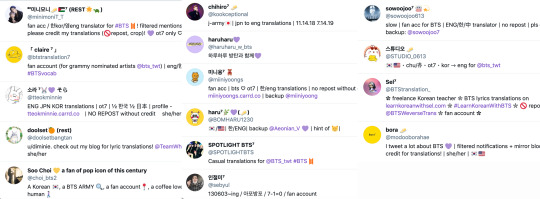

I’d also be very weary of member specific fanbases and chart accounts since they are known as perfect breeding grounds for solos, akgae and mantis, unfortunately, and some have been exposed for being akgae themselves.
42 notes
·
View notes
Photo

INKTOBER #4 - Radio
There is really no such thing as new technology on Posterra. Everything that seemingly could be discovered, constructed and abused already had its time in the spotlight of cyclical annihilation. Technology was the meaning of apotheosis as well as mighty downfall of dozens of civilizations that infested the globe like fleas on a mangy cat. Nowadays, tech is mostly… found out. Rediscovered. Dug from the ashes and figured out anew. As the pockets of progress and civilization solidify once more on the face of Posterra, more and more individuals have their basic needs fulfilled, safety guaranteed and resources given to put their minds exactly to such a task – digging through the remnants of the lost ages in hope to find something shiny and sensible. And so, Radio became the latest craze! Relatively easy to make and use, a little more troublesome to maintain, it became the vital source of long range connection, short range information sharing and even a tool of freedom, with pirate broadcasters putting their words to the hungry airwaves. But nothing on Posterra could be easy. Radio waves are of course not protected from the touch of the arcane… or the corruption of the Dreadwake. And there are many charming lunatics who see to put on their gloves made of skin of the unfortunate last experiments, cackle over the sparkling guts of a machine and go to town. And so, Radioblins were born – a strange mix of robots and flesh, zombified and programmed with simplistic algorithms. These ungainly creatures act as broadcasters, amplifiers and connectors for the expanding radio network, seeking far places to settle around, bringing the gift of the Radio to secluded places as well as to every corner of grander settlements. Nowadays they are a common sight on the streets and roofs of Wharf Town, polluting the air with the buzzing of their amplifiers, tolerated for the service they offer.
Inktober 2020 art will become avaliable in fully colored variants in ‘Posterra: Folks of the Wharf’ artbook, including extended lore, two short stories and map of the Wharf Town and surroundings. Stay Tuned!
#inktober#inktober2020#inktober 2020#inktober 2020 day 4#Radio#hybrid#biomechanical#machine#undead#goblin#posterra#postapo#scifi#fantasy#colored pencil#ink#inks#traditional art#daily drawing#mixed media
103 notes
·
View notes
Note
Oh cool, so maybe we could get a basic rundown on what they're the gods of just so we can ask more effectively?
This is a good question
In numerical order
- He of Construction (literal and metaphorical construction/building and designing both physical things and ideology, machinery, designed order, shelter/shielding, social unity/political leadership, reclusiveness) - She of Knowledge Given/Mercy (divine knowledge/granted purpose and its associated implications (bad) and responsibility, the sparing thereof, inspiration, temperance, mercy/forgiveness, lightning, light, fire) - He of Justice (justice, responsibility of the legal system, morality/ethics, deliberation/discourse, temperance, caution, indecision, ) - He of Communication (communication, any form of interaction with others, travel, transportation, manipulation, the Image:tm:, masks, presentation, moving through crowds, general two-sided interaction/the emphasis on oneself and the external interfacing) - It of Conquest (military power, advancement in every sense, controlled/needing-to-be controlled brutality/annihilation, drive, new and worse machines of war, weapons) - He of Protection Minute (protecting one and one’s own, the home, direct connections+attachment, personal obligation, death as in murder, domesticated plants, “had to be done,” feed your family with the garden you grew from your abuser’s corpse) - They of Protection Encompassing (protecting something larger/unconditionally, something outside of yourself, displacement, that kind of devotion, architecture, pattern, designed order again, cages, bones/dismemberment, violent rejection) - He of the Internal Dance (perpetuation, careful arrangement in the like rube goldberg fashion, puzzles, actual dancing, destruction, immobility, paralyzing fear) - She of Knowledge Sought (research, objectivity, seeking and finding knowledge, extrapolation, unraveling systems, naivety, associated knowledge-madness motifs, perception lenses, irresponsibility, moths) - She of Knowledge Kept (decision as to how to sort information, complacency, statistics, holding reserve, libraries, numbers/algorithms, - They of Knowledge Hidden (secrecy, erasure, Behind The Curtain, unspoken names, cloaking, doing things for lack of credit, walls, embroidery) - He of Knowledge Esoteric (exploration/experimentation, subjectivity, More associated knowledge-madness motifs, Whatever The Fuck Is Going On In The Ocean, medicine, poison, unethical experimentation) - [several] of Chronology (time, inevitability, fate/destiny/predestination, conformity, chains, nonconformity, defiance, existentialism, color)
OTHER NOTES - if you noted a lot of overlap you would be correct - they are frequently portrayed together, and are never portrayed truly alone; any portrayals that appear to have a single god will have motifs of at least one collaborator present - if you noticed contradiction: also correct. Their pantheon wide epithet is the Pantheon of Hypocrisy and it’s a key part of their theology to the point where they all have their own contradictory epithets (I haven’t worked them all out yet) - part of how they are remembered/deified is intentional; this is a post-apocalypse and possibly post-reset universe and some parts of the files set up for these eventualities exist, and though warped by time and regional drift, the core tenet that they made sure would be integral to the DNA of it all was constant vigilance Of authoritarian structures. The scripture basically has THE GODS FUCKED UP AND YOU WILL TOO POWER IS SOMETHING TO BE FEARED AND DESPISED scrawled on the wall in charred blood - the cosmology of the religion is cyclical and repeatedly apocalyptic; there is also no afterlife - nothing is strictly promised but some sects do subscribe to a promised perfect/untroubled iteration - the Pantheon of Hypocrisy has been syncretized w/ several other figures including MEKHANE - LOTS of portrayal goes on via statues/mythology/art/etc as reminders, because I think it is cool and they are culturally recognizable icons
ANYTHING here is free game 4 questionz :D
5 notes
·
View notes
Text
Do not assume that Business Analyst and Data Analyst are the same. You will be surprised to know the differences.
Business analytics focuses on the larger business implications of information and also the actions that ought to result from them, like whether or not a corporation ought to develop a brand new business line or grade one project over another. The term business analytics refers to a mix of skills, tools, and applications that enables businesses to live and improve the effectiveness of core business functions like promoting, client service, sales, or IT.

Graduates who are interested to become business analysts can pursue a post graduate program in business analytics to upskill themselves and qualify for the role.
Data analytics involves deep diving through huge datasets to reveal patterns and trends, draw conclusions regarding hypotheses, and support business selections with experimental insights. Data analysts try to answer queries like, “What is that the influence of location or seasonal factors on client preferences?”.
Individuals who hold a post graduate certificate in data science qualify for the role of data analyst and are more preferred by corporates during recruitment.
The responsibilities of a business analyst vary counting on the trade, however at their core need analyzing information and working on that knowledge to tell necessary strategic selections that improve the revenue or potency of a business.
To get a stronger understanding of what else a business analyst will do, we can look at the responsibilities of a business analyst as below:
Analyze giant amounts of complicated information to enhance the business with fact-based insights
Make recommendations on method enhancements that address business wants or resolve impediments
Influence, gather, define, and document complicated business necessities and processes
Work with internal groups and third parties to step up and resolve any problems detected in revenue streams
Perform analysis to gauge broader trends inside an organization’s revenue streams
Determine problematic areas with the info and analysis to work out the most amicable course of action to correct the info.
Like any other job, the responsibilities of a data analyst vary based on the business, however the core responsibilities are about interpreting and deciphering data.
Few important responsibilities of a data analyst are listed below
Conduct customer information exploration and analysis
Work with client-centric algorithmic rule models and personalize them to every customer as needed
Extract applicative insights from massive databases
Perform cyclical and impromptu measurement to support regular deciding
Support transcripts and analytics, like KPIs, accounting reports, making and optimizing dashboards
Facilitate and translate information into goals, metrics and visualizations
Create SQL queries to extract information from the info warehouse
Although data analysts and business analysts have a lot of in common, there are four main key differences between their roles.
1. Overall responsibilities.
Business analysts give the practical specifications that inform IT system style. Data analysts extract knowledge from the information produced and collected by those systems. Data scientists will typically automatize the business analyst’s activities and will be able to give a number of the business insights additionally.
2. Salary.
Data analysts earn a mean remuneration of INR 11.5 Lakhs, as per the information on Indeed.com. Skilled candidates with post graduate certificate in data science from reputed institute always have the higher edge in compensation. Business analysts earn a rather higher average annual remuneration of INR 13.2 Lakhs. High standard post graduate program in business analytics clearly increases the salary of business analysts. Business analysts tend to create additional, however professionals in both they can undergo the transition to the role of a “data scientist” and earn an average data science salary of INR 18-20 Lakhs.
3. Skillsets.
Business analysts need data science information additionally as skills associated with communication, analytical thinking, negotiation, and management. Data analysts need similar skills with an additional in-depth specialization in technical knowledge manipulation.
4. User interaction.
As project facilitators and managers, business analysts typically have additional direct interaction with systems users, clients, system developers, etc. than data analysts do. That’s as a result of business analysts could oftentimes interview folks to find out additional regarding the ways in which technology may be improved to assist business processes. They work collaboratively with others throughout the length of one project. Though data analysts could consult internal subject matter consultants at the beginning to determine necessary datasets, the majority of their work is finished individualistic.
8 notes
·
View notes
Text
Slicing up polyhedra with Hamilton
My explorations of Hamiltonian circuits on the face of a cube and other polyhedra continues.
A Hamiltonian circuit around the faces of a polyhedon touches each face once and once only and returns to the start. Normally we think of a circuit around the vertices of a polyhedron, but I’m interested in the path around the faces of a polyhedron, equivalent to a path around the vertices of its dual.
I had managed to cut a tubular path on the surface of a polyhedron, given a sequence of faces in the circuit. So the pressing problem was to be able to compute Hamiltonian circuits for ‘any’ polyhedron.
Computing Hamilton circuits
It’s well-known that the computation of Hamiltonian circuits is NP-complete but there are clever ways to do it quite efficiently. I learnt from Bob Bosch’s book Opt Art about the Concord TSP (Travelling Salesman Problem) solver and I look forward to understanding how to express the Hamiltonian circuit problem for solution as a TSP.
However, for experimentation and for small numbers of faces or rather small numbers of small faces, an exhaustive search is feasible. I designed my algorithm so that it could be restricted to adjacent edges - that’s no restriction for triangular faces so the maximium size of the search space for a polyhedron with only trianges (like an icosahedron) is 2^N where N is the number of faces. I had hoped that the restriction to adjacent edege might find a quicker solution for the dodecahedron, but there were no such solutions. For the dodecahedron with its pentagonal faces, the maximum search space is 4^N ie 2^2N = 2^24. ie about 16 million. (I’m sure lower bounds are known). I made no attempt to eliminate paths which are ‘the same’ because I’ve no idea how to do that. The computed circuits all start on face 0 so there are no cyclical duplicates.
In practice the search space is much smaller that that upper bound. The openSCAD algorithm finds 2048 circuits for a dodecahedron in about 5 minutes (Core I5 Thinkpad).
It’s useful to be able to visually check that a circuit is Hamiltonian. For example one circuit has faces indexes [7, 10, 1, 3, 9, 4, 11, 6, 5, 2, 8, 0]. In openSCAD I can add the face indexes to the faces to check. The path is marked with a tube, square in cross-section. The path runs from edge-midpoint to edge-midpoint in a series of ‘arc’s or straight lines if the edges are parallel : ‘arcs’ because if the edges dont have equal length, the arc radius is interpolated between the edges. The arcs always meet the edge at right-angles. Subtracting the tube from the polyhedron incises the circuit on the surface: [ view STL ]

Cutting a ball-bearing track
My orginal aim had been to cut a tube around the path in which a ball bearing could run, as Bob had done with his hand-carved cube. It looked difficult to print such objects well on my home printer, and to be able to get the ball into the track, so I turned my attention to cutting the polyhedron into printable pieces.
Cutting a polyhedron
The Hamiltonian circuit cuts the surface of the polyhedron into two parts. Thus we can cut the solid into two parts by constructing a parting surfaces which extends from the path on the surface of the polyhedron to the centre.
This parting surface is itself quite interesting. This is the dodecahedron circuit above [View STL]
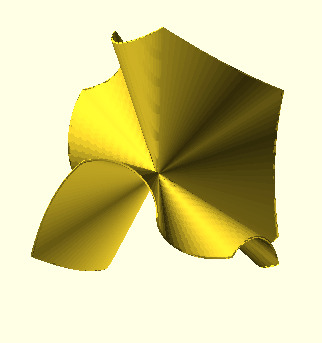
Separating the halves
I wondered how to separate the two halves - seems impossible in openSCAD but I discovered that it was trivial to separate the generated STL in Slic3r - you just load the STL and click Split to separate the two halves. This allows each half to be saved as STL and printed. For some polyhedra and circuits, the two halves are the same and two copies can be fitted together:
Tetrahedron:

Cube - 1 [View STL]

cube 2 [View STL]

Others interlock and can’t be re-assembled - difficult to print too!:
Icosohedron

In other case, the two halves form a chiral pair - these are the two halves of a truncated tetrahedron:

Some prints: L to R , top to bottom: Cube style1, truncated tetrahedron (chiral),Cube Style 2, octahedron, pentagonal prism

Multiple cuts
To make the solid assemblable, we can use two or more cuts. On a cube there are only 4 circuits composed only of arcs. Two of these cuts the cube into 2 pairs of parts: [view STL]



The dodecahedral challenge
A single cut creates two inseparable pieces:
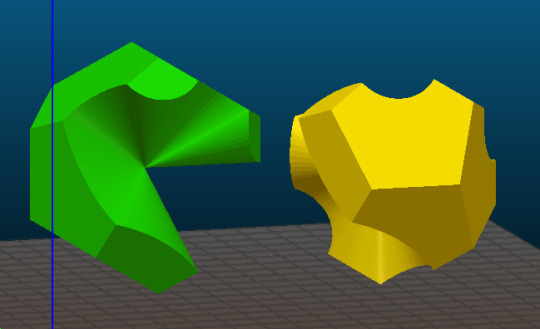
but multiple cuts would create a multi-part division where the pieces are more likely to be separable, and hence assemblable, perhaps in a constrained order. Two cuts of the dodecahedron still created large interlocked pieces, but three randomly selected circuits cut the shape into 13 separate and different pieces.

It would be a challenge to print them all and not know until the end whether the dodecahedron can be assembled - it would be good to be able to compute the best selection of the circuits to achieve this - something for another day!
Assembly
The pieces don’t reassembly securely. One approach would be to hollow out a cavity and add magnets to the piece. This cube has been split and a cylinder, whose direction is normal to the plane at the centre, removed to make space for a magnet in each half:
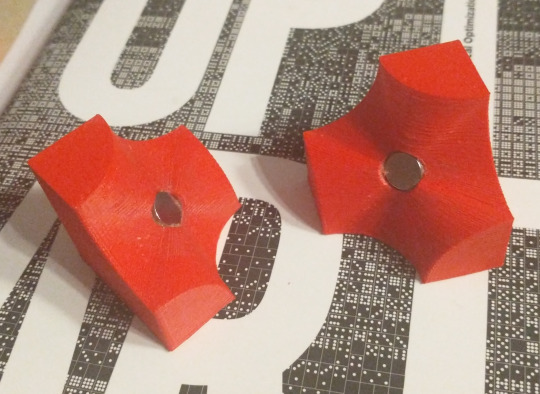
OpenSCAD
This project is a good demonstration of the power of this language. As a functional language with vector operations, it's capable of computing the Hamiltonian circuits on a polyhedron defined by faces and vertices, and of computing a path of points along one of those circuits. But it’s also able to handle the rendering of a polyhedron as a solid and, using the CSG operations, to union,hull, and difference objects. A very powerful combination, although sometimes difficult to know which paradigm to work with.
The code is on GitHub
2 notes
·
View notes
Text
Journal: Final Reflection

The fashion industry has complex links to many other sectors, including manufacturing, advertising, raw material processing, transport, and retailing. The immense profits to be gained in the retail industry give rise to the desire to engage in unethical practices. When suppliers, distributors, designers, or customers are exploited or treated unfairly, fashion industry executives have an ethical duty to improve the situation.
Within Fashion Ethics and Culture course, we were given the opportunity to explore the breadth of creative, aesthetic, and social/cultural expression of design through the lens of ethical and historic considerations – as it is and how it needs to change, the role of the MENA region and its relationship to fashion media.

As a student of DIDI, I felt the same link and inspiration between the Fashion Ethics and Culture course and my vision of how I want to be as a future designer and how I should change the current fashion industry status quo with my future career path. The course creates a creative paradigm for learning ethical fashion design through the lens of ethical and historic considerations. Students are introduced to fashion history, cultural criticism, contemporary culture, and the diversity of representation including ethical considerations and perspectives.
In my opinion, this course plays as a moderator between all other fashion courses we study and extend to other courses with depth like sociology and design histories and theories to link and emphasis all courses material in a dynamic way. We covered various subjects relating to Body Image Problems, Fur Trade Issues, Cultural Hegemony and Appropriation, Consumer Over-consumption, Environmental Effects, and Concerns, Advertisement Conflicts, Brand Name Forgery, Sweat Shop Working Conditions, and Exclusiveness and Injustice Issues; that simultaneously vary from micro to macro scale through lectures, group activities, open discussions in class, and individual presentations.
The True Cost Formula
Investigate your Wardrobe
Doughnut Economics
ATCAC-Disrupting the Fashion System
Earth Logic: the turning point
Careers in the Fashion Industry
The future of Garment Technology in Circular Fashion
Market Segmentation
Fashion for Good: Virtual Tour
Fashion & Society
Made in America
“Luxury: Behind the mirror of high-end fashion”
Empathic Design Process
SOKO Kenya - A people first company
Innovative Fashion Marketing
Key trends innovating Fashion Marketing
Fashion for Good: Virtual Tour
Untangled Egyptian Beauty Standards
The Fashion & Race database
The Modist- Modest Fashion Dream
About Time: Fashion and Duration
The It Girl: Ashley Al Busmait
I enjoyed the above-listed topics and guest lecture discussions we had this semester, but certain to a whole new way of perceiving the world. I would love to deepen and expand my knowledge on the technology and circularity of the fashion industry future as well as focus on modest fashion and ethical practices and success and failure aspects of the Modist business experience. Whether through merging my learning outcome within this semester to my nest fashion studio or final thesis.
Here's my list of the most meaningful subjects for me and some of the highlights of my recent blogs on these topics:

ATCAC-Disrupting the Fashion System
ORIGIN AND HISTORY
Atacac is a Swedish fashion studio that Jimmy Herdberg and Rickard Lindqvist created in 2016. Atacac is designed to disrupt the current fashion system. Atacac is like a laboratory for developing ideas and principles. Then they work as consultants sharing that with other brands to improve their design. The other way they work with other designers is what they call Share-wear. When they release a new product in their online store, they also offer the 2D pattern and the 3D model of the garment for free download. This builds a community of home sellers and independent brands that use their patterns and designs. In certain terms, you can do whatever you want. There is a Credit Common Licence connected to the Share-wear which means you can use it commercially in any way you like, and you can make improvements to it, But you need to give credit back to Atacac if you use it commercially and market the product. You also need to make your development available for other people to keep developing further.
For me ATCAC is a brilliant business module example that is trying to blow the entire system to the ground, I loved how I saw ATCAC embodying every principle, I have been learning for the past 3 years. This blog post and the investigation behind it gave me hope that I can succeed in doing something different with my future dream brand.

Innovative Fashion Marketing
Stretchy Kids’ Clothes Petit Pli gets a growing identity
A sustainable fashion design example that offers apparel that evolves as the wearer grows older has an innovative branding that sounds like “more human” and “less professional." The idea is to reduce the waste of apparel and save parents’ money as children progress up a range of sizes in the first three years of their lives.
It needs time and education to promote meaningful behavioral change. We assume that we are too late for much of our generation. We assume, though, that we are just in time for the next era of LittleHumans. The brilliance of the brand strategy is in anchoring on the opportunity where new parents and young children are more open to improvement and learning than any other part of our community. They do everything not only to promote constructive behavioral improvement but also to make it as seamless as possible.
Marketing as a term became cliché of how much brands are using it without actually making the right –positive impact on their users, within this blog post example of how marketing approach could be current, supportive and extending the brand value to further stage where the client loyalty will be granted due to that extended value, this reminded me of applying the product-service systems methodology, where it's not only the brand responsibility to produce and market a product but they innovate different approaches to extended their after-sale services and product value to emotionally engage their clients.

Empathic Design Process
Empathy is the core of the entire process of Design Thinking. Putting ourselves in someone else’s shoes reinforces our ability to interpret information, and lets us understand how other humans perceive the world around us.
The realm of fashion design is shifting from an external focus on the industry, or an internal focus on integrating technology, to an empathetic focus on people. While it’s not too difficult to rally people around this general idea, it can be hard at first to understand how to translate it into tactics.
I ask myself as a designer, how do we make a good connection between a fashion worker and a customer? My solution to this question is to make fashion employees the hero of the story, create brand ideals around them. Plan company modules to be a win-win for staff and stakeholders. As designers, we should reconfigure how the framework is giving back to the societies through which we work. I expect, as a future fashion designer, to build a secure working environment that will help better the lives of single mothers in Egypt. By offering comprehensive educational opportunities and curating future working talents. The Empathy Concept process will be incorporated not only to understand the consumers but also most critically, to understand the true needs of the heroes behind my future brand.
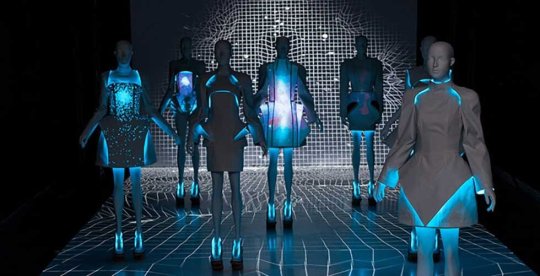
Technology & future of Circular Fashion
Fashion has always been a major hub for innovation — from the invention of the sewing machine to the rise of e-commerce. As technology, fashion is both forward-looking and cyclical. At $2.2 T, the apparel industry is now one of the top sectors in the global economy. Nowadays, apparel technology is rising more than ever. From robots that sew and cut clothing to AI algorithms that anticipate style patterns, to VR mirrors in dressing rooms, technology automates, customizes, and speeds up every aspect of fashion.
In the optimistic scenario, the future will be led by innovators and collaborators, the industry will leap forward in developing digital passports for clothing that carries an internationally recognized digital asset trigger that could be accessed by designers, retailers, recyclers, and customers alike. This type of standardized infrastructure and labeling approach means that not every brand or approach provider has its own patented approaches, leaving customers stuck in the sea of things to consider. In this way, the future of fashion technologies could truly unify the industry around common practices that would make circularity more visible to everyone.
Reference list
Accenture and H&M Foundation (2018). Circular x Fashion Tech. [online] Available at: https://www.accenture.com/_acnmedia/PDF-74/Accenture-GCA-Circular-FashionTech-Trend-Report-2018.pdf [Accessed 3 Oct. 2020].
By Insider Trends (2019). Why does Swedish clothing brand Atacac give its patterns away for free? - Insider Trends. [online] Insider Trends. Available at: https://www.insider-trends.com/why-does-swedish-clothing-brand-atacac-give-its-patterns-away-for-free/ [Accessed 14 Sep. 2020].
CB Insights (2020). The Future Of Fashion: From Design To Merchandising, How Tech Is Reshaping The Industry. [online] CB Insights Research. Available at: https://www.cbinsights.com/research/fashion-tech-future-trends/ [Accessed 26 Oct. 2020].
CHANGE, W. (2020). THE WARDROBE CRISIS. [online] THE WARDROBE CRISIS. Available at: https://thewardrobecrisis.com/the-magazine/2020/8/26/4-tech-innovations-that-will-change-the-future-of-sustainable-fashion [Accessed 26 Oct. 2020].
CLO (2020). Live Q + A with Fashion Studio Atacac. YouTube. Available at: https://www.youtube.com/watch?v=PHpiD5u0e1w&feature=youtu.be [Accessed 14 Sep. 2020].
Dawood, S. (2019). Stretchy kids’ clothing Petit Pli gets an identity that grows. [online] Design Week. Available at: https://www.designweek.co.uk/issues/1-7-april-2019/stretchy-kids-clothing-petit-pli-gets-an-identity-that-grows/ [Accessed 31 Oct. 2020].
Design Indaba (2013). Data Dress: A tangible representation of your online movements | Design Indaba. [online] Design Indaba. Available at: https://www.designindaba.com/articles/creative-work/data-dress-tangible-representation-your-online-movements [Accessed 26 Oct. 2020].
Dezeen (2017). Ryan Mario Yasin’s Petit Pli kids clothing expands to fit as children grow. YouTube. Available at: https://www.youtube.com/watch?v=cJ8VSvkz_4w [Accessed 31 Oct. 2020].
Dubai Design Week (2019). GGS Success Story: Featuring Petit Pli by Ryan Mario Yasin. YouTube. Available at: https://www.youtube.com/watch?v=3a2eIix1rUI [Accessed 31 Oct. 2020].
Dyson on (2019). Petit Pli: The unlikely fashion brand that wants to end industry waste by making clothes that grow. [online] Medium. Available at: https://medium.com/dyson-on/meet-the-inventors-fabric-fantastic-c5f18d7639bf [Accessed 31 Oct. 2020].
Fashion United (2020). The future of garment technology in circular fashion. [online] Fashionunited.uk. Available at: https://fashionunited.uk/news/business/the-future-of-garment-technology-in-circular-fashion/2020091750927 [Accessed 26 Oct. 2020].
Givens, D. (2020). ASOS Unveils Its Made In Kenya Collection Collaboration With Soko Kenya. [online] Black Enterprise. Available at: https://www.blackenterprise.com/asos-unveils-its-made-in-kenya-collection-collaboration-with-soko-kenya/ [Accessed 27 Oct. 2020].
GLOBAL FASHION AGENDA (2020). Design for Longevity. [online] Designforlongevity.com. Available at: https://designforlongevity.com/page/about [Accessed 14 Sep. 2020].
Herdberg, J. (2020). Kokokaka - Work. [online] Kokokaka.com. Available at: https://kokokaka.com/work.html [Accessed 14 Sep. 2020].
Krantz, J. (2017). Atacac uses game tech to disrupt the fashion system - MAGIC FABRIC. [online] MAGIC FABRIC. Available at: https://magicfabricblog.com/atacac-uses-game-technology-change-fashion-system/ [Accessed 14 Sep. 2020].
LeVine, S. (2018). Automated fashion is now a reality in new Chinese store. [online] Axios. Available at: https://www.axios.com/fashion-automated-alibaba-china-store-d476b4a4-d74d-410e-9518-bea2449203da.html [Accessed 26 Oct. 2020].
Morrison, H., Petherick, L. and Ley, K. (2019). THE FUTURE OF CIRCULAR FASHION A COLLABORATIVE REPORT BY ACCENTURE STRATEGY AND FASHION FOR GOOD ASSESSING THE VIABILITY OF CIRCULAR BUSINESS MODELS. [online] ACCENTURE STRATEGY AND FASHION FOR GOOD. Available at: https://d2be5ept72nvlo.cloudfront.net/2019/05/The-Future-of-Circular-Fashion-Report.pdf [Accessed 2 Oct. 2020].
NB Studio (2019). Petit Pli - Brand Identity. [online] The Drum Awards. Available at: https://www.thedrumdesignawards.com/drum-design-awards-2019/brand-identity-design/petit-pli-brand-identity [Accessed 31 Oct. 2020].
Partners, K. (2017). PROTOCHIC. [online] PROTOCHIC. Available at: https://www.protochic.com/stories/2017/3/17/kenyan-manufacturer-soko-kenya-partners-with-british-retailer-asos [Accessed 27 Oct. 2020].
Petit Pli (2020a). MISSION 2: FUTURE OF HUMANITY Earth’s Hidden Figures. [online] Available at: http://ryanmarioyasin.com/hosting/BLMcomic.pdf [Accessed 31 Oct. 2020].
Petit Pli (2020b). Petit Pli. [online] Petit Pli. Available at: https://shop.petitpli.com/ [Accessed 31 Oct. 2020].
Petit Pli (2020c). Unstick The Sticky Alien! [online] Petit Pli. Available at: https://shop.petitpli.com/blogs/news/unstick-the-sticky-alien [Accessed 31 Oct. 2020].
Pfaff, M. (2018). Amesterdam University of Applied Sciences. [online] AMFI.nl. Available at: https://amfi.nl/news/technology-is-transforming-the-fashion-industry [Accessed 14 Sep. 2020].
Sherriff, L. (2020). This Company Is Making Children’s Clothes That Actually Grow As The Kid Does. Forbes. [online] 16 Feb. Available at: https://www.forbes.com/sites/lucysherriff/2020/02/24/this-company-is-making-childrens-clothes-that-actually-grow-as-the-kid-does/?sh=81b30233f70f [Accessed 31 Oct. 2020].
Sohini Dey (2018). Can artificial intelligence and fashion create a smart stitch? [online] mint. Available at: https://www.livemint.com/Leisure/Vp81luEXDz3lWuvvYVYIdO/Can-artificial-intelligence-and-fashion-create-a-smart-stitc.html [Accessed 26 Oct. 2020].
SOKO Kenya (2020). SOKO Kenya. [online] Soko-kenya.com. Available at: https://www.soko-kenya.com/ [Accessed 27 Oct. 2020].
The Trampery (2019). Petit Pli : Future Design for “LittleHumans” - The Trampery. [online] The Trampery. Available at: https://thetrampery.com/2019/12/02/petit-pli-future-design-for-littlehumans/ [Accessed 31 Oct. 2020].
2 notes
·
View notes
Video
youtube
<youtube>"https://www.youtube.com/embed/V_gQ6n1mcZA"</youtube>
<h1>Why did the iPod go out of fashion?</h1>
This video very aptly explains why Apple’s iPod was the single greatest music listening experience that we’ve experienced: you can plug into distraction-free music, wherever you go.
So why did it die?
When the iPod touch came out, it quickly replaced its internet free predecessors. We had a shiny new gadget, we wanted it. We wanted all of the functionality we could muster, crammed into one device. But do consumers always know best? Given the choice to switch back to an iPod Nano, I would take it.
<h2>I may be crazy, but give me a Nano</h2>
I’ll be the first to admit that I love Spotify. The recommendations and personalisation are unprecedented and make the listening experience incredibly seamless. In an age without radio, Spotify is the saviour we need to discover new music and support small artists. But you have to ask yourself, how often are you truly disconnected from your phone?
For me, I’ll never be further than 1 AirPod connectivity radius from my phone. If someone wants to reach me, they can. I’ve been conditioned to answer calls, texts, and emails immediately, no matter the time or day. I wholeheartedly believe that this is to do with the fact that everyone is connected. You can be sure – to some level of certainty – that the person you’re texting will see the message within 5 minutes. Is it rude to respond later? No. Will you feel guilty for not responding straight away? Yes.
This has a huge impact on social development and mental health. If you grow up believing that you must be at the beck and call of anyone – even strangers – on the other side of your phone, it will undoubtedly translate into real life. Gen Z is famous for simultaneously being aggressive and fearless activists while being terrified to raise simple concerns about a meal to their waiter. We have been conditioned to put ourselves last. If we were to break the chain of absurd interconnectedness and relieve the expectations of always being available, we would have a much better chance of forgiving ourselves for taking a moment to focus on us.
<h2>But how could the Nano succeed?</h2>
The solution is two-fold: change the marketing strategy, and increase functionality.
As I write this, I realise that now might be the time for Spotify to enter the game of audio devices. What the consumers love is the ability to stream & discover music, audiobooks, and podcasts, with pseudo-unlimited storage.
<h3>Marketing</h3>
There are two distinct target audiences for this device: Boomers & Zoomers. Okay, I actually mean (Boomers + Gen X) & Zoomers, but it sounded cooler the first way.
In my experience, Gen X & Boomers enjoy clean and simple tech. They want to listen to their music. That’s it. Targeting towards them would look like nostalgia, simplicity, and discovery. Keep the experience similar to what they’ve had before but play up the disconnectedness.
These generations are generally late-adopters who rely on the recommendations of their (grand)children. That’s where the Gen Z come to play.
Gen Z want simple. They want retro. They want to care about their mental health and the wellbeing of others. Give them the option to jump back in time to an mp3 player that will allow them to be completely disconnected. Listen to your music without the fear of getting a call or text. Play up the long-term goal of releaving the pressure to be on standby every second of every day. Open up discussions around the benefit this could provide & let them recognise these expectations within themselves. Your Gen Z will be your early-adopters, and eventually influence the Gen X & Boomers.
<h3>Hardware</h3>
Design is next; designing an updated, successful mp3 device will be tough. Perhaps seperated mp3 players are cyclical with the fashion. Regardless, fashion has brought us bumbags and handbags for all genders. Now more than ever, we don’t care about the number or size of devices we’re carrying around.
The physical device will need to be sustainably produced. Gen Z want to reduce waste and ensure fair trading and construction processes. Give an insight into how the devices are made. Employ underprivileged or underserved communities for good wages. These devices will be more expensive, but in the climate we live in, it’s necessary.
<h3>Software</h3>
Functionality should be at a minimum, but equatable to a Spotify or Apple Music app on your smartphone. This device can be supremely optimised for audio playback and discovery. Here’s my vision:
Load time is next to nothing. We cache not only the songs that the user generally listens to, but also the songs that we think the user might want to listen to. We need to find an optimal starting point (what song/playlist we expect the user to listen to first) and press the user to start there. This will allow us to deliver the super-low latency experience almost every time.
We optimise the cache based on the listening habits of the user. If this user historically listens to the same song/s on repeat, we use an LSU (least recently used) cache. This will delete the least recently used files and allow us to constantly keep in memory the songs that we believe the user will want to access in the near-term future. Similarly, if a user generally listens to entire playlists, we use a MRU (most recently used) cache which will bias towards discarding the most recently listend to music.
Extrapolating listening habits to premptively load and cache songs will be another huge part of a successful stand-alone mp3 device. Imagine a device that would allow you to continue on your Taylor Swift deepdive while you’re stuck in the NYC subway for 30 minutes. This would be revolutionary to oh-so-many New Yorkers who currently need to make sure all of their audio is downloaded prior to subway trips.
We can use an exploratory method to determine the current listening path of the user. If you imagine a tree data structure and we’re traversing using an A* algorithm. The head node is the current song, and we generate its children based on historic listening habits of the user, along with those of the wider listening community. If I’m listening to Baby by Justin Bieber (Ft. Ludacris), it’s pretty likely that my next song will either be: old school JB, newer JB, other nostalgic songs from the late 2000s, or back to my normal listening habits. With each additional song that I make a decision on (ie. listen to or skip), we become more certain about what my next choice will be. By doing this, and expanding the cache in an A* kind of way, we can try to keep all songs of interest in memory, all the time.
We need Spotify for one main reason: data. This optimised caching system will only work if we have incredible amounts of data. To get this data, we need trust, time, and good data storage and modelling practices. Starting as a new company trying to gather this data would either be incredibly expensive, or incredibly time consuming.
All I can say is, let’s do it!!
2 notes
·
View notes
Text
Detection

Detective Agency
Detection now plays an increasingly important role in our lives. The capacity to move, circulate, restore familiar patterns of work and sociality depend on the capacities to detect the presence of viruses, to detect trajectories of transmission, and surges and flattening of curves. The substantial elaboration of surveillance apparatuses is now well underway.
But there are also other more minor or subtle matters of concern when it comes to detection. These are about not only how present conditions are read in terms of detecting trends and patterns, but also the ways in which people detect themselves in a cascade of reports, stories, and analyses. How they see themselves a part of or apart from particular renditions of reality. There are those who detect that this crisis is a definitive crisis, that from which the once normal can never be restored, that is the harbinger of a new world and economic system. There are those who experience this time more cyclically, who detect the return of conditions that they already experienced some time ago, that reset the game, that wipe out all of the activisms and efforts of decades or a generation.
For example, many progressive activists who have worked with poor communities and social justice issues detect the present conditions as a return to 1998 and the end of the New Order regime of Suharto. All the work that had been done to strengthen the capacities and livelihoods of low-income settlements, to build new civil institutions is detected to have now largely been undone in a matter of weeks. On the other hand, decades of activism in India aimed at making the state assume more responsibility for ensuring the social welfare of the majority suddenly materializes in a substantial program of food and income support but in a context where many of the intended beneficiaries have at least momentarily disappeared from view. The practices of opacity that enabled many to secure livelihoods under the radar now complicate the ability of the state to reach them. Here, detection becomes an intricate game: the need to be fed but the need to avoid capture.
These conundrums are set within a larger game of contestation about ultimate values—the exigency to live versus the exigency to be free, reducing detection to all kinds of exhausted binaries, or at least arguments about proportionality. What proportionality is proper for what kinds of populations? Should those whose livelihoods are dependent upon day labor, hawking, waste recycling, artisanal factories, and marketing be forced into more extremes of impoverishment in the interest of reducing infection and morbidity rates? What degree of enforcement of spatial restrictions constitutes heavy-handedness?
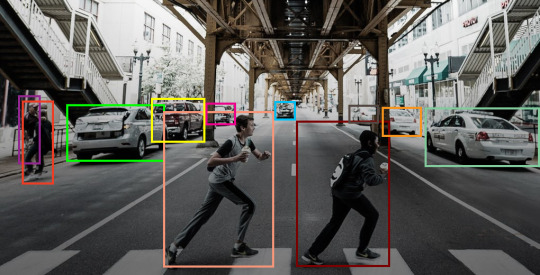
A little bit of this, a little bit of that
Recipes for disaster would suggest a proportionality of ingredients, as would the rectification of disasters. But what if proportionality was not evident nor possible? What if it was unclear the extent to which existent realities on the ground were at one and same time self-destructive, virtuous, frivolous, necessary, generous, and manipulative? What if it were impossible to tell exactly what is virtuous or debilitating? In such instances everything become experimental, heuristic, a wager on a particular disposition. Detection stretches to enfold nearly impossible calculations as to the likelihood of viral transmissions in urban settlements difficult to lockdown, where interactions between exposures to various outsides, circuits of mobility, probability of contacts with those engaged in foreign travel, access to the tools of prevention, such as soap and water, are estimated as probabilities according to differing proportionality of contributing variables.
While it is clear that the survival should be extended wherever possible, that a right to survive should be embedded in every context of governance, just what constitutes that right, what secures it, what makes it possible in a given context may not entail either the possibility of working out proportions or that it even should. In other words, if initial responses to a pandemic require everyone to stay at home almost all of the time, what is the definition of home in which one must stay. If the outside is set off against the inside, to what extent are the dangers reversible, where certain dimensions of the outside are more than safe than anywhere else. If small factories in dense neighborhoods are being shut down because their production is considered inessential work, under what conditions and product lines could it be deemed essential, especially where these factories have always specialized in repurposing their tools and skills for other things. For all those petty traders who are taking whatever wares they have to sell to the rooftops, servicing the demand for goods issued from below, what happens to a refiguring of the street if these traders prefer not to return to the “ground. If youth still running in the thick lanes of popular neighborhoods force the elder authorities indoors, how might youth not so much take their place but rehearse their capacity, make something new in the here and now. The point here is that proportions depend upon the stability of their ingredients or variables, and that this may not be the time to insist upon such integrity.
We may face a situation where preferences as to who can move where will be issued on the basis of detailed profiling of an increased range of data, just as surveillance has been structured on the basis of probabilities that certain correlations of variables pose specific kinds of risk. Whichever way such expansions of data analysis may go, there is an expansion of a grid on which individuals are positioned. Critical decisions may be increasingly made, not on the basis of the basic grids of race, class, national origin, or age but on one’s positionality on a proliferating series of grids that represent a constant reworking of multiple variables that produces a score calibrated to particular tasks, settings, futures expectations, and needed functions.

When figuring doesn’t seem to matter
It is not so much that systems of racialization are upended, extended, or reinvented, but that a more intricate gridding system provides an illusory “real” that such racial or class distinctions no longer are the primary things that matter. We all know that black people are more vulnerable to bad outcomes in the current situation because blackness ramifies across all kinds of relative deprivations and over-exertions. But this “clarity” ends up always being denied, excised from the reigning proportionalities or registered only as an epidemiological fact.
Rather, such extensions of the grid are constituted to provide an assurance of equality, but an equality that loses the conventional terms of comparison, and importantly the public negotiations about what social (biological, historical) differences mean. Instead of society democratically working out what equality means, it becomes increasingly a matter of a “mathematics of singularities”. As a result, I may have certain privileges, access, and rights based on an algorithmically deliberated correlation of thousands of date points that generate a reality of my existence beyond any common vernacular. What makes me equal to others then is not evaluable in terms of what I have access to but that the terms of any decision are largely inaccessible to everyone.
Additionally, the very need for equality is obviated in the emphasis that for every moment in every place and for every function or activity there is a “right” person to occupy that moment. When algorithmic deliberations generate composite scores for specific requirements, they constantly run different correlations among different constellations of variables so that each variable does not possess a static or definitive weight, but is always recalibrated in terms of what at that moment is being compared. Thus the fact that I have a university education, or am a 68 year old white man, or that I have worked in 57 different countries in the world or have two daughters, etc. are variables without definitive weight, so that wherever I am positioned on an expanding grid, I do not know for sure exactly how much any single factor “counted” in terms of my positioning. There is a thus an equality of uncertainty that inhabits this system of expanding grids.
If there are any prospects then for equanimity, for a sense of collective action based on a fundamental negotiability of meaning of the very language we use in order to approach and represent each other, it may seem necessary to get off the grid, off the imposition of more intricate segmentations, cadastration, mapping, remote sensing, and enclosing. While the grid may have indicated a public realm, of a public connected to the grid of provisioning, manifesting an infrastructure of commonality, not only has many aspects of such a grid been overwhelmed, through disinvestment, surges of demand, privatization ,and its conversion into a speculative asset, but the logic of the grid itself stretches the “public” beyond forms of recognition that can be actively deliberated by residents at different scales. It is not just that public utilities and transport systems have been taken apart, but rather that infrastructures are sutured and articulated across territories in such variegated and consolidated ways as to render the terms and financial underpinnings inaccessible to the various forms of the public they are intended to serve.
Yet, at the same time are grids not even more necessary at this moment. As the state is mobilized or pressured into doing things it never considered doing—mass provisioning and income support, will grids not be needed in order to make more visible the populations that need this support? If the exigencies of everyday survival in desperate condition may propel vulnerable populations in greater levels of opacity, of operating under the radar, then do they not need to be coaxed back into view as the conditions to which they might be adequately serviced?
Again, here is the question of proportionality between visibility and invisibility, between knowing precisely what kinds of variables are contributing to particular situations and the need to keep things out of precise detection. And so perhaps we need new practices of detection, those that are able to bring things sufficiently into view in order to engage them but at the same time accede to letting them go, assuming other shapes and operations.

Gumshoes in invisible coats
Standard forms of detection always assume a truth that is to be uncovered, even if what is detected exceeds the existent terms of understanding. Something needs to be known. So it is not so much a matter of whether the truth uncovered is the truth, but rather the self-confidence of detection to generate a sufficient reason, to reiterate itself the definitive method for establishing the basis for decision.
But as Rob Coley illustrates in drawing upon the classic film noir, the detective is less interested in the “real story” than in trying to work out the unanticipated complications that the pursuit of the mystery has unwittingly thrown up. Detection seeks less to uncover complicity and conspiracies than to detach itself from the accruing story. It is more interested in the tactics of ensuring that things do not come to light, for to understand the crime to be solved means seeing how the crime has permeated into all aspects of living, and how the transparency of detection might leave nothing in its wake.
Of course this is familiar to us through Jean-François Laruelle’s notions of generic detection, where the objective is not to find the relations among things, not to put together all of the clues and various into a sufficient explanation, but to stay with insufficiency. Where the proportions cannot be worked out.
Why is this important? Because across urban districts around the world, thousands of stories of adaptations, risks, ventures, retreats, and retooling are emerging that are need to be told and heard in their own emerging terms. That need not be reduced to levels of compliance and suffering. That need not be reduced to the proportion of populations obeying orders. This is not a critique of pandemic policies or a valorization of the disobedient. But in the inevitable work arounds of spatial segmentations and categorization of whose work counts there are experiences that don’t fit into any yet common language, that need to be detected as blips, glimmers, and glitches, possibly emerging into some more elaborated vernacular, but also perhaps just disappearing without trace.
Detection here then is not the method through which individual and populations are subsumed into a system of proportionality—more or less healthy, more or less immune, more or less eligible, more or less valuable. Instead, it points to a space or composition capable of holding within it things and processes that may be related to each other, or not; where what something is may be multiple, but that it does not owe its existence to how it is positioned within a network of multiplicities, through which it accorded particular statuses and potentialities. This is not dissimilar to Fanon’s point that the wretched are an infection at the heart of colonialism, but an infection, that while being localized, is also immune to definitive detection.
Here, rather, is a detective that discovers within his or her “beat” a “real” that is “this one, right now, right here” and which has no definitive connection to anything else. But by doing so, such detection levels the playing field, renders something no more or less important than anything else, and thus avails it to unthought of (so far) courses of action. One could see detective work as a form of rendering, of making things (up), of making something available to a particular (wider) use, of putting things in people’s hands that they didn’t have before or couldn’t imagine using. Less uncovering than rendering, detection then is a way of keeping things moving along, of telling stories that extend a person’s relationship with the world, rather than detection being the grounds to legitimate the removal of persons from worlds.
3 notes
·
View notes
Text
Here is why I think Covid-19 is probably the New Normal:
People can get it more than once. Ending shelter in place/self quarantine too early will cause a spike in infections. The rush to ‘fix the economy’ will basically guarantee that many places will re open too early.
The large number of unemployed people without access to health insurance, plus all of those who will probably be evicted as soon as landlords feel they can get away with it, is going to lead to a glut of people being hired to fill newly open positions in businesses that were forced to close. With people desperate to pay bills and avoid eviction, and the sheer number of people looking for jobs, companies will hire for low wages and no/minimal benefits
It may slow down for the summer and pop back up once the weather gets cooler. There are all sorts of algorithms and stuff predicting how many will die and what the peaks are. I would expect multiple waves of it, due to the fact that many people get it and are asymptomatic. Once one ‘peak’ slows, another will pop up within a couple weeks, depending on how quickly businesses and stuff are allowed to re open.
Estimates on when there will be a vaccine seem to have it being available within 18 months. We all know antivaxxers ain’t shit. There have been measles outbreaks. Those dumbasses will absolutely risk getting Covid 19 if it means not getting vaccinated.
I highly doubt the vaccine will be free. It will be expensive, difficult to get, and there will be shortages. The wealthy will be the first to be inoculated, just as they were the first to get tested. They’ll live their fine lives in their mansions while everyone else has to find a way to live and work through cyclical outbreaks of a deadly disease.
#aron's opinonion#coronavirus#i mean i am a worst possible scenerio person#so take it with a pinch of salt#but this is just like my opinion man
2 notes
·
View notes
Text
To hell with Amber Alerts (because no one wants to fix it)
There are a lot of things in this hyper-modern world and day and age that gets shoved in your face and down your throat. Cell phone notifications. Personalized advertising. Donald Takeadump's tweets. And Amber Alerts.
It used to be that Amber Alerts are something you only hear about when you tune in the news, or maybe even on a highway digital sign (as if we need more driving distractions). Now with advancing mobile technology you can not just have a TV or radio broadcast interrupted with an obnoxious buzzing noise to alert the whole world of a missing child along with a horrible electronic voice reading the alert message, you get them shoved straight through your smartphone. Not everyone likes the latter idea when they see how terribly it is executed.
Whatever happened to missing child posters on milk cartons? (To be honest, I have never in my life encountered a missing child poster on a milk carton, this is something I only seen on TV.)
I don't know if Amber Alerts are something other countries besides Canada and the US have. And as a matter of fact, the "Amber" in Amber Alert is an acronym for "America's Missing: Emergency Response Transmission," although it is also named after a kid from Texas whose abduction and murder somehow inspired this idea of issuing emergency alerts in the event of a child abduction. Which makes me wonder why it's called Amber Alert in Canada, other than because we like to borrow and adopt so much from the Americans to match what they are doing—at least we do not capitalize all the letters ("AMBER Alert") like they do in the States.
I sure do not want to have something like this named after me.
But going back to the main point of this: having Amber Alerts pushed onto everyone's mobile devices not only means everyone is force-fed the messages with no opt-out as per government order, which comes with a very obnoxious buzzing noise, they get pushed at all sorts of times. Even in the middle of the night when many people are in a deep sleep and have their phones still on. Which meant a lot of people got pissed they were rudely awoken to the news of a missing child. Some of those folks called 911 to complain about it. The authorities then have to go on the news to defend the practice of push-notification Amber Alerts.
Ever since sometime in 2018 when Canada implemented the practice of mobile Amber Alerts, we've had at least 5 of these push-notification incidents in Ontario alone. One of these cases tragically the girl was found dead and her non-custodial father was charged with her murder. The rest I believe the child was found safe, including one where the father picked his daughter from school as usual and ends up being treated as a child abductor but released without charges, and most recently with two boys and their grandfather, as if the granddad is the abductor (turns out he was quite confused). Like, wonderful, right? Let's all pat ourselves in the back and masturbate to each successful Amber Alert, whoopie-fucking-do.
The implementation of these mass force-fed alerts in its current form begs a lot of questions to be asked about its nature. One of these Alerts concerned a missing child from Thunder Bay, where people as far away as Toronto got phone alerts for. Why are people in Toronto being force-fed an Amber Alert regarding a kid thousands of kilometres away? What do you expect the average person to do, head over to the airport with pitchforks waiting for a flight from Thunder Bay to land so we can save a child, capture the abductor and be the fucking hero? That is, even assuming they would be flying to Toronto, as if that's what an abductor would be doing.
Hell no. Let's be realistic here. If I was consciously abducting a kid, and wanting to fly far out of town, I'd get the hell out of the country quickly even if it meant leaving everything behind! I know what I am doing is wrong and I do not want to be caught by national authorities, am I right?
There are other questions that need to be asked about the mass force-fed approach to Ambert Alerts and the concept itself. Like, why in fuck's name are people receiving alerts in the early morning hours? Who is the fucking retard who think it is appropriate and effective to issue an push-notification Amber Alert at 3 in the morning? (Oh don't tell me an algorithm is behind that!) If these alerts are intended for a general public audience, why would anyone think 3AM is an okay time to send an alert out? Who is responsible for getting these alerts out and how it is done? Why are Amber Alerts (at least in Canada) being treated with the same level of "presidental level" alertness on your smartphone as something that is a big major apocalyptic national threat, like a nuclear bomb heading our way?
These incidents of direct-to-phone Amber Alert messages have quickly established a pattern of where news stories about people calling 911 to complain about being disturbed by the alerts quickly accompany the incident itself. It's to the point of a predictable cyclical script, just like how mass shooting incidents in the States have become a script. And it goes like this: an Amber Alert is issued, child is found (or not), endless news reports of people complaining to 911 makes the rounds as authorities justify the system and remind people not to clog 911 with complaints, wash rinse and repeat.
We can all agree we should not call 911 to bitch about an Amber Alert. Absolutely not in the middle of an active Ambert Alert when authorities want the 911 lines free to be able to collect tips on the fact. You want to fine people who take up valuable 911 time with their anger? Go ahead. But then where should we voice our frustrations? Facebook and Twitter? They're great for bitching about anything, terrible at being heard with the goal of getting something accomplished. Heck, if you read these articles about the complaints, you'll notice no one ever says anything about where more appropriate to leave a complaint. It's like they do not want to hear them, and that is probably the case, that the authorities behind the Amber Alert schema are content with the way they have it set up.
But the complainers do perhaps have a valid point. Why on fucking earth are people being awoken by an ill-timed Amber Alert on their phones? What do you expect people to be doing once awake, run out in their pyjamas and roam the neighbourhood looking for a missing child in a half-asleep stupor, going only on a vague text description of the child? "Amber, Amber, where are you?" Or why are we getting alerts about a kid who is so far away as to be of little concern?
I get that each missing child case needs to be evaluated by police before they resort to publicizing a missing child, or even issuing an Amber Alert. After someone first reports them missing, cops have to make sure the kid is truly unaccounted for, that they are not somewhere lost in school or at a friends or relative's place. They have to quickly investigate reports that someone else may be behind their disappearance. By that time, it's possible that several hours has passed, it's possible the child in question is far away from town. By the time an Amber Alert goes out, it is possible indeed, as with the case of Riya Rajkumar, the subject child is dead. Yet we still credit the Amber Alert a success because it brought in attention and tips that helped locate the deceased child. The system works again.
Gotta admire the blind optimism of the pro-Amber Alert folks.
Or why is EVERYONE being forced to receive these alerts? This is something I surely did not agree to nor signed up for. Why is this responsibility—a civic duty, perhaps?—being shoved and downloaded to us all? What do they expect us the general public to do in these cases? Seriously though, no one has ever explained to us what to do or equipped us with necessary skills in the event of an Amber Alert. What do you want me to do, seriously? You may think it's "obvious," that is to keep an eye out for the kid and report to police, but it's not that simple (will get to that later on).
It is pathetic on the part of S-ociety as a whole that no criticism of the current system will be entertained. In fact, critics and whiners are quickly villified by defenders of the Amber Alert as heartless horrible selfish narrow-minded assholes. They think it's sad and unfortunate many others feel differently about mass Amber Alerts than they do. News agencies entertain themselves much with such punditry and op-ed pieces in response to the 911 complaining phenomenon in support of our holy Amber Alert system. "Shame on you," writes one person in a half-assed column (as if anything in the world has ever gotten accomplished by screaming the statement, "shame on you"—the truth is: no). And apparently we need to "be more educated" about these force-fed alerts. One guy on the website of a New Jersey radio station even writes, "Suck it up."
Suck it up? FUCK YOU! How would you like it if you were rudely waken up in the middle of the night by an Amber Alert? Maybe I should have you locked up in a room and be tortured with that distinctive Ambert Alert buzzing noise (they really could not have chosen a less obnoxious tone?) over and over, see how you like it.
And that is the thing with authorities and supporters including the mass media (who always love a good missing child story to sensationalize): they are clearly incredulous and in denial of any problems with the way Amber Alerts are currently deployed. They beat the drums of the party line with their rhetoric, always congratulating themselves and proclaiming the Amber Alert a success because it works once again as expected, always pulling the "what if it was your child" card. They are so full of themselves, they do not see anything wrong with mass force-fed Amber Alerts in the middle of the night, refusing to see the absurdity and ineffectiveness of such a scenario from the perspective of the opposition. They are content with the status quo, everyone else be damned. Nobody wants to acknowledge a problem exists.
"Wake Me Up Everytime!," proclaims the title of one news opinion piece in support of late-night Amber Alerts. Such joy!! It really is as if the defenders and supporters have never ever been in the experience of being awoken by a 3am Amber Alert. It seriously makes me wonder what those people who don't see an issue with 3am Amber Alerts would really do when they themselves are rudely awoken by a 3am Amber Alert. Look at their phones and then fall back asleep? That would be ironic and just as useless as those who make angry 911 calls about this when a child is supposedly out there in danger. Of course there are people out there already awake at 0300h for whatever reason (graveyard shift jobs, travelling around, just left the bar after last call, etc.), but most people are like deep asleep, and expecting the sleeping majority to be able to act upon a late night Amber Alert is seriously retardedly delusional, let's be real here.
A conclusion can be made of all this: criticizing and suggesting improvements to the Amber Alert system is a new social taboo. Even in this so-called democracy of ours with freedom of speech and all that jazz, we are only allowed only one approved opinion of many issues, even something as petty as the way the Amber Alerts currently work. So much for freedom. And that is troubling. And unacceptable. And backwards. Taboos and stigmas are retarded social concepts/mechanisms anyhow and has no place in a modern sophisticated society that likes to regard itself as advanced and progressive.
I have no tolerance for mass stupidity. I have even less than zero tolerance for willful ignorance. It is sad that a topic like Amber Alerts manages to combine the two: the stupids who complain via 911, and the willfully arrogantly ignorant defenders of the system who themselves get angry over the idea that others don't want to be subjected to Amber Alerts. That combined with the emotionally driven irrational logics that informs the subject and how it is being shoved in our faces without consent, really makes it hard to accept being on-board the scheme.
It really should not be taboo to suggest that Canada's current mobile phone Amber Alert schema needs adjustment, nor should people feel ashamed to suggest they have the right to opt out of receiving direct Amber Alerts. The latter idea sadly is surely to invite much the same opinionated disgust from Amber Alert supporters who believe alerts MUST be pushed onto every single person on earth and that it will not be effective without that stipulation. Just another way S-ociety shoves itself into us all.
Let's face it: 99.99% of the world population, or even 99.99% of a city, are in NO position to be able to do anything about an Amber Alert. They are too far from anywhere, too busy to be allowed a chance to act, asleep(!), etc. Just receiving a message about a missing child and thus knowing there's a missing child out there somewhere is good to know, but it accomplishes nothing. There are those who do care enough to take the trouble to keep an eye out and report when they think they see something matching the alert description. Good for them. The rest of us however, we should be able to not be subjected to such alerts if we do not want them. Since when the fuck did Amber Alerts become a social obligation?
What evidence exists to suggest mass alerts are effective anyways? Besides, force-feeding Amber Alerts onto everyone's faces and ears is asking too much of us all, especially considering that much of S-ociety is full of stupid people. Much of us are too lazy to properly toss an empty soda can into the recycling bin instead of the trash pile, and yet we're expected to help find a missing child at a moment's call? (These are the same dumbasses who call 911 to bitch and whine about Amber Alerts, after all.) I know all this sounds heartless, especially to the pro-Amber Alert crowd, but that is the reality that perhaps they do not want to accept. Lest to join the Donald Takeadump parade and make up your own "alternative facts" on the matter, I guess.
People behind force-fed Amber Alerts are concerned that the public's annoyance to these alerts will nurture a dismissive "boy who cry wolf" situation where we all learn to ignore them. You damn bet that concern is real. It's like car alarms: they are most often false alarms triggered by mundane events like someone bumping onto a car and suddenly the whole neighbourhood is disturbed by an obnoxious blaring noise that won't shut up, such that we have learned to ignore them and do nothing because we all have figured no one is really trying to steal a vehicle (and car alarm makers have done nothing about improving their products). When you shove Amber Alerts onto the phones of literally everybody, with a disturbing loud blaring noise, and these alerts are of no concern to most of us, you damn shall bet we will learn to do nothing except be annoyed by yet another new modern society nuisance. Besides once again, what the hell can we do?
I can appreciate why the Amber Alert scheme exist, no really I do. If I had a child and my kid went missing one day, of course I would want all the resources available to have my child return home safely. But personally I would not want to subject literally everyone to the search effort. That honestly seems selfish to me. Pro-Amber Alert peoples like to argue that those bitching about unwanted Amber Alerts are selfish, but I like to spin that around. Frankly, why is one kid in one moment considered that much more valuable than everyone else? Why does that not sound selfish?
Which leads me to want to take this opportunity to discuss another thing about Amber Alerts and child abductions cases in general at a more deeper sociological kind of level, generating even more questions and thoughts no one else has the balls to openly present and discuss. Likewise, seems like nobody else in the world thinks and see the way I do on this topic in my typically socially cynical nature; I really do feel lonely about it.
S-ociety's preoccupation with missing children is a uniquely capital-W Western obsession. I don't think there are other societies in this planet that cares so much about missing children as does Western nations. I have a friend from another country who is perplexed with all these Amber Alerts, commenting that where he is from, missing children is a common occurance, that they wouldn't be able to have an Amber Alert system. Indeed, there are plenty of countries out there where kids go missing all the time, where child abductions happens more often than not, and the authorities do not have the resources to go after every case, or even care at all. So yes indeed Western society should really count its blessings and consider itself lucky in this regards that it has the resources to even obsess over missing children and come up with something like Amber Alerts. You may even want to think of this as a "first world problem."
And why obsess over missing children anyways? To me, Amber Alerts is a product of western society's child innocencism, which is what I refer to this idea or myth that children are inheriently innocent and thus must be protected at all costs from all harms of the world, real and perceived and ficticious. Innocentizing children contributes to their objectification in S-ociety. Children lack agency, for the inexplicable reason why they are referred to as minors and are treated as objects—chattel, essentially—in child custody cases, where usually the children have no say whatsoever on the matter, that someone else—the courts, lawyers—is making critical decisions on what's best for them on behalf of the children. We speak of children in objectifying terms, treat them as if they belong to someone like any other property. When missing children cases make the news, it's easy to feel like they are not persons, but rather characters in an ongoing story.
The mass media LOVES missing children cases, it's no wonder why they latch on quickly with Amber Alerts. Cases involving abductions and even murder at the hands of complete strangers—the Elizabeth Smarts, Tori Straffords, Jonbenet Ramseys, etc etc.—are very sellable and engaging to a very dumbass audience, and the press are happy to sensationalize these stories to death. (You think people who follow these stories closely are going to do anything about helping to solve the cases? Hell no!) It is to the point to dangerous exaggeration, of making people think stranger abductions are a common threat in western society, which in turn reinforces our mass preoccupation with missing children, justifies Amber Alerts and other such measures, and pumps up moral panics and fears that our precious innocent children are always in danger.
Stranger danger is overrated. In fact stranger abductions are very statistically rare. A kid in western society is much more likely to be abducted by someone within their own family, usually a non-custodial parent. It should not be a surprise that most, if not almost all Amber Alerts involve a parent or other relative of the subject child. Which now begs the question of whether a kid at the centre of an Amber Alert is truly literally always in danger. The recent Riya Rajkumar case was an exception (and if convicted, seriously the father should be given the death penalty, but we don't have that in Canada anymore). I mean, why would a parent kidnap their own child and then kill them? It is a very difficult question to answer as the motive is unique to every case. But statistically I would doubt that a kid is in any alarming danger. In most cases I bet the non-custodial parent snatches their own kid simply to have that kid to themselves. They care for the kid just as much but do not trust the other parent, don't care what the custody agreement says because it's not in their favour, let's get out of here. It's still kidnapping, but should we really be exaggerating the danger factor of the situation?
(Heck, it's pretty pathetic how exaggerated any fears concerning children is. We fear the stranger pedophiles and equally sensationalize sellable news stories of arrested pedophiles. However likewise, a child is more likely to be sexually abused by someone within their own family than by anyone else—or by R. Kelly for that matter. Sad but true, but we don't much about that in the news right?)
Child abduction/disappearance cases conditions the populace to fear the worst every time. Another thing I have a problem with regarding Amber Alerts and missing children cases: it lacks perspective. The topic is so irrational and emotionally driven, facts and data have no place when all you care about is the safe return of a child no matter what. Nobody wants to listen to anything else. The lack of perspective easily leads to why there is such a quickly developing institutionalized bias against naysayers of the current Amber Alert implementation—those in support are so full of themselves on the topic, so emotionally driven, that they shut out any facts and arguments, pulling guilt trips and drawing rebuttals that are only about visceral emotions. Amber Alerts have become a polarized topic, institutionally rooted in "think of the children!" mentalities.
I'd like to as well question who gets to be granted the Amber Alert treatment, because it is quite telling about the nature of our obsession with missing children, and also because no one else seems to be asking or seeing it my way. People like to say that missing children are in danger, thus why we need Amber Alerts. Okay then, why is it that only certain cases of people gone missing gets the Amber Alert treatment? If an old lady with advanced dementia wanders out of her house and doesn't find her way back, do I get awoken at night by an Amber Alert? NO. Should we? Is my example lost old lady not just as in danger as an abducted child? Or how about this: a young kid barely wearing much clothing, somehow wanders outside in the cold winter. Does this child get the Amber Alert treatment? NO as well. Even though this kid is just as much in danger—of possibly freezing to death, never mind being snatched by a stranger on the streets heaven forbid—the most we the public will hear about this kid is a breaking concerning local news story of plenty, but not an official Amber Alert. These two examples do not pass the main criteria of an Amber Alert, which is that they are not a child who is possibly abducted.
Or how about this: recently we had the case of Wanzhen Lu, some Chinese guy who was kidnapped by some thugs from the parking garage of his Markham condo, and found days later in the Muskoka region. That incident, perhaps because of the high level of unusualness and shock, generated a lot of media attention throughout Toronto and even the whole of Ontario, along with the usual appeal to the public to keep an eye out for him. But it surely didn't generate an Amber Alert. Why? Because Lu is a grown man, not a child. What if he got hurt and murdered by the disguised thugs? Sure was a real threat, but apparently he is not as worthy as an innocent child for a kind of Amber Alert treatment.
Why is it only certain kinds of missing people—kidnapped children—gets the Amber Alert treatment, even though we may as a society genuinely be concerned for all kinds of missing people? Why is it that we think all missing children are precious and at risk, and only a certain kind of them get the Amber Alert treatment? We may be absolutely concerned for the well-being and safety of a kid who wanders off in the dead of winter, but our phones do not go off making noises and receiving messages about such a kid. It is to me unfair, and honestly borders on hypocrisy, because it is as if we only value certain kinds of missing kids more than others, enough to warrant an Amber Alert. Why is one kid more deserving of our attention than others in this heightened, exaggerated manner? The social values we ascribe to missing children and Amber Alerts needs to be questioned.
Anyways, it frustrates me that S-ociety as a whole is in denial that the Amber Alert system we have now established in Canada is flawed and needs improvements. I can understand why you would want to have an Amber Alert scheme in place, but when you subject these alerts to literally the whole population at the most intimate level—ie. through their personal mobile devices—you better expect some backlash and critiques. If Alerts are getting pumped out in the middle of the night as if there is nothing wrong with that, you better stand back and evaluate the process and effectiveness thereof. It is NOT wrong to suggest we can make this system better.
Equally it should not be a taboo to insist we have the right to opt out of getting force-fed Amber Alerts. What is wrong with that? Did I or you consent to these types of "emergency" push alerts that we are told concerns us all even if it really doesn't? Amber Alert maniac defenders like to make you think you are heartless for wanting to not receive Alerts, that the system only works best if EVERYONE gets them. Bullshit. One theme that keeps coming up when reading these articles and columns on the Alert backlash, is that we should all know that there is a kidnapped child out there in immediate danger, even if we cannot do anything about it and it's 3 in the morning. What do you expect us all to do, fucking thoughts and prayers? What good will that do? Honestly, knowing there is a missing child out there is just as good as doing nothing, which of course both is not helping the situation at all. Knowing there is a kid out there doesn't mean much to many of us, any more than having to hear about traffic reports that do not affect us at all. Again, 99.99% of people are in no position to be able to assist in any way. It is counterproductive to cast a very wide net to catch a needle in a haystack, to evoke two Western cliches in one. I honestly cannot be bothered to keep an eye out for license plates or a kid that matches the vague description of the Alert, this is asking too much of us all. Those who do believe we all ought to make an effort to act on an Amber Alert even when it's late out as if it's an obligatory civic duty, I will place at an incredibly high standard, that is to say I expect those who believe we all ought to make an effort to act on an Amber Alert to themselves better be out there looking for the damned kid. You want to save on receiving angry 911 calls? Make it possible to opt out of Amber Alerts. Those who do care about Amber Alerts are free to preoccupy themselves and act accordingly, just don't force this onto everybody. There's nothing wrong with not having to give a shit about a situation that you cannot do anything about.
If there is one thing society/civilization/humanity likes to do, is impose itself onto everyone else and the world around it in whatever ways. And quite frankly it pisses me off when S-ociety forces everyone to concern themselves with matters that don't concern or affect them or may not be in their own interest (amongst other imposed upon social norms like being told how to eat, what to do, what to think, what goals to have, how to look like, etc., all of which pisses me off—S-ociety itself pisses me off), imposing upon everyone an expectation of being able to relate to the situation, especially in irrational ways where mass emotional tugging and guilt-tripping are exploited, to the point where I honestly don't give a shit about missing children. Besides, Amber Alerts is a mass Western anxiety/panic I can do without. It contributes to the exaggerated nature of how we irrationally interpret cases of missing people, and the disenfranchisement of children and youth in S-ociety due to its preoccupation with child innocence myths.
7 notes
·
View notes
Text
Duke Reviews: Happy Death Day 2U
Hi Everyone, I'm Andrew Leduc And Welcome To Duke Reviews Where We're Continuing Our First Annual October Monsterween...
Last Week, We Talked About The First Happy Death Day Movie Now We Move Onto The Sequel, Happy Death Day 2U...

Taking Place After The First Film's Ending, This Film Sees Tree Gelbman Being Transported To Another Dimension, Where She Must Relive A Different Version Of The Same Day Repeatedly With A New Killer On The Loose While She Attempts To Go Home, Will She Succeed?
Let's Find Out As We Watch Happy Death Day 2U...
The Film Starts With Ryan (Carter's Roommate) Inside Of His Car Being Woken Up By Someone's La Bamba Car Horn As He Walks To The Campus To The Building Where His Room Is But Unfortunately He Can't Stay As Carter Is Making Out With Tree (Basically The Last Scene Of The Last Movie)...
Getting A Phone Call From One Of His Friends, Samar, He Tells Ryan To Come To Their Lab Now As Him And His Other Partner, Dre (Short For Andrea) Have Made A Discovery And That Is That Their Invention Known As The Sisyphus Quantum Cooling Reactor (Or Sissy For Short) Automatically Went Off At 12:01 AM Yesterday And They Have No Idea What Set It Off...
But As The 3 Try To Figure Out How It Happened, The Dean Of The College Marches In To That Their Project Is Suspended Due To The Rolling Blackouts And Broken Circuits And Bulbs That Have Been Throughout The Campus Also Because It Hasn't Been Making The Only Thing That The Dean Is Apparently Interested In...

After The Dean Storms Off, Ryan Gets A Picture On His Phone Of Him On The Couch, Looking Over To Where The Picture Was Taken, He Finds Nobody So He Decides To Go Outside In The Hopes Of Finding Whoever Did It But Instead Ryan Gets Another Message And Follows That To The Chem Lab...
There, Ryan Finds Nobody, But When He Checks The Supply Closet, He Discovers..
youtube
(Start At 0:59, End At 1:15)
Waking Up In The Same Morning Like Tree, Ryan Wakes Up In His Car And Does The Same Stuff He Did As Before Only When He Reaches His And Carter's Room, He Tells Carter That He's Feeling A Sense Of Deja Vu And That The Day Reset When A Guy In A Baby Mask Killed Him....
Despite Knowing It To Be Impossible As Lori Is Dead And That Toomes Is Dead (But I Know That Fact To Be Impossible As Tree Killed Toomes In The Perfect Timeline But When She Ate The Cupcake The Day Reset Hence Toomes Can't Be Dead) Tree Tells Ryan Her Story Through A Recap Of The First Film...
Grabbing A Bat, Tree Tells Ryan To Show Her Where He Saw The Killer To Which He Takes Her To The Scene Only To Find Nothing, But When Ryan Hears A Noise, He Ends Up Whacking Samar In The Head When He Thinks That He's The Killer When He Sees A Baby Mask On Him...
Saying That He Found The Mask In The Hallway, Samar And Dre Leave When The Dean Of The College Marches In To Tell Ryan Again That The Project Is Terminated, Asking To See This Project, Ryan Shows Tree And Carter Sissy...
Telling Them That It Was Made To Prove That Time Can Be Slowed Down On A Molecular Level, Ryan Shows Tree And Carter The Data And Tells Them That It Went Off Yesterday At 12:01 AM, Which Makes Tree Realize That Ryan Started The Time Loop...
Despite Knowing That's Not What Sissy Was Made To Do Samar And Dre See This As A Discovery Of What It Actually Can Do And That Maybe It Was An Unintended Reaction, With Tree Telling Them That They Need To Figure Out How To Close The Loop, Ryan Tells Her That They Have No Idea How As It Fired On It's Own...
Interrupted By Danielle, She Asks Tree Where She Was During Their Meeting As Since Lori's Death Their Sorority On Red Alert And Danielle Worries About How They'll Attract People With An Attempted Murder On Their Hands, After Meeting Samar, Danielle Walks Off...
With Ryan Not Wanting To Die, Carter Suggests The Perfect Place To Hide Which Is The College's Sports Arena...
(Sarcastically) Yeah, Good Choice, Carter, Perfect Place To Hide...NOT!
While At The Game, Tree Spots Tim, Who Took Her Advice Of Finding Himself A Piece Of Man Ass (Even Though It Happened In The Same Timeline Where Toomes Died) She Also Recieves A Picture Of Her And Her Mom On Her Cellphone Which Makes Her Wonder If All The Events Of The Last Movie Were For Nothing
But With Carter Telling Her That Even If It Was, It Wouldn't Mean Less, The 2 Of Them Kiss As Alarms Start Going Off...
With The Arena Being Evacuated, Ryan Is Confronted By The Killer Forcing Him To Run..
youtube
(Start At 0:43, End At 2:29)
Saved By Tree, They Decide To Unmask The Guy To Which They Discover That It's...Old Man Smithers, The Creepy Janitor! No, Just Kidding It's Actually Another Version Of Ryan...

I Know It's Weird, But Turns Out This Ryan Was Trying To Close The Loop But Somehow He Got Knocked Into This Dimension And That The Longer Him And Their Dimension's Ryan Exist In This Dimension The More Danger They'll Be In So. He Tells Tree And Carter That They Have To Kill Their Ryan...
But Not Wanting To Die, Their Ryan Ends Up Placing It In His Hands To Solve The Problem, So, He Activates Sissy To Try To Get Rid Of The Other Ryan, But Samar And Dre Enter Only To Be Followed By The Dean And 2 Security Guards, They Try To Stop Ryan But The Machine Activates With The Flower Duet Playing In The Background As We Fade To Black...
The Next Day, Tree Wakes Up In Carter's Room To Discover That She's Back In Her Time Loop...
youtube
(Start At 0:33, End At 2:51)
Arriving At The Sorority, Tree Notices That Something's Missing Which Leads Her To Realize That Danielle Didn't Confront Her About Who She Slept With But Moving Onto Lori, Tree Confronts Her About The Cupcake But She Tells Tree That There Isn't One As She Goes Off To Her Job As A Nurse...
This Gets Tree To Realize That Something's Not Right As She Takes Ryan And Carter To The Cafeteria To Explain Everything That Happened Up To Now. With Tree Wondering If There's 2 Of Her, Ryan Tells Her That That's Highly Unlikely As She's Probably Stuck In A Quantum Cyclic Dimesion, With Tree Here And The Tree Of This Dimension Trapped In Another Dimension Somewhere In The Multiverse...
Having No Idea What The Multiverse Is, Ryan Explains It To Tree...
And To Explain It To My Viewers, Here Is Family Guy's Own Little Genius, Stewie...
youtube
(Start At 0:15, End At 0:38)
Thank You, Stewie...
With Danielle Approaching, Tree Gets Ready To Face Her Wrath Only To Discover That Not Only Is She Somewhat Of A Nice Person Here But She's Carter's Girlfriend In This Universe...

Having Enough From Danielle, Tree Answers A Phone Call From Her Father To Remind Her About Their Birthday Lunch To Which She Tells Him That She'll Be There In A Little Bit After Which She Takes Off But Not Before Telling Ryan To Be At The Lab At 3:00 So They Can Fix This...
Going To The Luncheon With Her Father, He Tells The Waiter That Before They Order They're Waiting For One More Person, A Person That Will Change Tree's Perception On Everything....Her Mom....
Yep, Tree's Mom Is Alive In This Universe...
Happy About This Discovery, Tree Decides To Tell Ryan To Shut Off The Machine. With Carter Wondering Why The Change, All Tree Tells Him Is That Everything Is Different Here Before She Asks Carter About His Relationship With Danielle But He Figured That She Already Knew As They Live In The Same House...
Eventually Dropping The Subject, Tree's Sees This World As The Best Version Of Her Life As Her Mom's Alive And Lori Isn't Out To Kill Tree But After Seeing Gregory Benson Talking With His Wife, Tree Decides That She Needs Time To Herself To Figure Out What To Do...
Returning To The Sorority, Tree Looks At Her Phone All Day Only To See That None Of The Memories On It Are Hers, With Danielle Eventually Entering She Wonders What Time Tree Is Coming To The Party (Like In The Last Movie) But As Danielle Talks To Her, Tree Notices On Tv The News Report That Toomes Is In The Hospital, Meaning In This Universe He's Still Around...
Telling The Secretary To Call The Police, Tree Grabs An Axe So She Can Fight Toomes, She Discovers That Only The Police Officer Is There. Arresting Tree, The Officer Tells Her That Toomes Went Down To The OR With A Nurse But As The Officer Takes Tree Away, He Gets Killed By The Killer...
Making A Run For The Elevator, Tree Is Saved By Lori, Who Tells Her The Same Story That The Officer Did Meaning The Killer Is Not Toomes (Or Her For That Matter)
With The Power Out, Lori Bars The Elevator Open So Her And Tree Can Get Out, But As They Walk Through A Floor That's Under Construction, Lori Is Killed By The Killer Which Forces Tree To Run To The Stairs So She Go Up To The Rooftop Only To Fall Off Of It Like Wile E. Coyote...

With The Day Reset, Tree Gets Pants On So She Can Tell Ryan To Meet Her In The Lab In An Hour...
With An Hour Passing, Tree Tells Ryan That She Needs To Stay In This Dimension And Asks Him To Close The Loop, But Ryan Tells Tree That This Will Be A Trial And Error Situation Where They Have To Rule Out Every Variable In Order To Find The Correct Algorithm
But Samar Points Out That Even If They Do This, They'll Have No Record Of Their Progress Especially If They Have No Memory Of It Once The Loop Is Reset, With Tree Believing That She's Screwed, Carter Gets An Idea That Since Everything But Tree's Memory Resets, She May Have To Become A Living Record...
But Knowing That She's Not A Scientist, Tree Tells Them That It's A Bad Idea Especially If There's A Killer Who'll Be After Her Until The Loop Is Closed, This Leads Samar To Come Up With The Suggestion That Tree Just Kills Herself Before The Killer Does...
Tree Doesn't Like That Idea At First But Seeing That There's No Option, She Decides To Go With It...
And So, We See Everyone Working On Closing The Loop While Tree Spends Time With Her Parents And Spys On Danielle And Carter And Lori And Gregory While Also Resetting The Day By Electrocuting Herself, Poisoning Herself With Draino, Jumping Out Of An Airplane Without A Parachute, Getting Mulched In A Tree Mulcher (That Has A Back To The Future Reference) And Jumping Off Of The Belltower...
But All Throughout Those Kills She Has Stomach Pains And Faints Again, Landing Her In The Hospital Where Tree Meets This Universe's Gregory Benson, Who Has No Idea Who Tree Is But Is There To Tell Tree The Same Thing He Told Her The Last Time He Took Her X-Rays In The First Film...
Asking What Time It Is, Gregory Tells Tree That It's 9:30 To Which Tree Warns Him That Lori Is About To Die And He Needs To Stop Her From Going Down To The OR, Which It Appears Gregory Does As He Exits, But When Tree Gets Up, She Finds Lori's Dead Body On The Floor As Toomes, Dressed As The Killer Attacks Her...
youtube
(Start At 2:16, End At 2:40)
With The Day Reset, Tree Goes To The Lab To Give Carter, Ryan And His Friends All The Failed Algorithms, To Which They Realize That There's Only One Left And It Works...
But With One Varient Closing The Loop And The Other Sending Tree Home And Closes That Loop, Which Means It's Decision Time And Tree Decides To Stay In That Dimension...
But As They Turn On The Machine It Shuts Off Because There's A Virus In The System And It'll Take Six Or Seven Hours To Fix The System, Telling Ryan That She's Living On Borrowed Time, Tree Walks Off...
Following Her, Carter Asks If Tree Is Sure About This Decision To Which She Tells Him That She Is, Despite The Fact That Lori Will Probably Die Tonight If Does Close The Loop Realizing This, Tree Tells Carter That She Can't Be Responsible For Everyone...
Telling Her That She's Sounding Selfish, Tree Tells Carter That To Not Make Her Choose Between Him And Her Mom Which Leads Tree To Tell Carter That In The Other Universe They Were Together...
Asking Tree What If She's Wrong? And That She's Meant To Go Back To The Other Universe Tree Tells Carter That She Can't Because She Doesn't Want To Lose Her This Leads Carter To Tell Her That She Already Did And That None Of This Is Real If She's Living Another Person's Life That Doesn't Belong To Her...
But She Has The Opportunity To Do Something Most People Only Dream About And That's Having The Chance To Say Goodbye. But Before Carter Can Say Anymore, Danielle Approaches Which Causes Tree To Leave...
Going To The Restaurant To See Her Parents, Tree Starts Feeling Chest Pains Again Which Causes Them To Worry About Her But Asking Them To Take Her Away From Campus, Saying That She'll Explain Later, They Do Just That...
Passing By A Power Plant In Their Car, Tree's Mom Talks With Her About Cinnamon Rolls At A Place Called Morrow Bay To Which Tree Doesn't Remember It As It's Wasn't Her That Did That...
Stopping At A Hotel For The Night, Tree Talks With Her Mom About If She Ever Wondered What Her Life Would Be Like She Couldn't Be With The One She Loves And If Being With That Person Meant Losing Someone Else To The Point That You Could Never See That Person Again.
To Which Tree's Mom Answers That That's Life, Sometimes The Past Pulls Us In One Direction And Sometimes The Future Calls Us Somewhere New. Wondering How She Knew That Her Dad Was The One, Tree's Mom Tells Tree That She Didn't She Just Took A Leap Of Faith...
Seeing The News Report From The Hospital, Tree Discovers That Not Just The Police Officer And Lori Are Dead But Carter Too, Tree Tries Calling Ryan To Tell Him To Stop Sissy But Unable To Reach Him, Tree Takes Off In Her Parents Car So She Can Go To The Power Plant To Kill Herself And Reset Time...
youtube
(Start At 0:53, End At 1:46)
With Time Reset, Tree Tells Carter That That Is The Last Time She's Dying For Him...
Later At The Lab, Everything Is Fixed For Tree To Go Home, But Before She Does She Decides To Do Some Things 1. Fix Everything With Lori And Telling Her To Break Up With Gregory, Saying That He's Not Worth It...
2. Talk With Danielle, However As Tree Goes To Do That She Finds Pleasuredome Nick In Her Bedroom Meaning That Danielle Is Not Little Miss Nice Girl As Everyone Believes And She's Cheating On Carter...
And Finally 3. Say Goodbye To Her Mom, With Tree Saying Everything She Has Always Wanted To Say To Her Mom, It Turns This Scene Into A Tender Moment And Honestly It Makes Me Cry...
Returning To The Lab, Ryan Turns On Sissy To Send Tree Home But They're Stopped By The Dean Who Pulls The Plug On Sissy And Wheels It Out Saying It Will Be In His Office Under Lock And Key...
With Carter Suggesting That Tree Just Reset The Day, Tree Tells Him That She's Getting Weaker To The Point That If She Resets The Day Again, She Won't Come Back, This Leaves Them With Only One Option And That's To Steal Sissy From The Dean's Office With Both Samar And Dre Believing That It's A Bad Idea, Both Carter And Ryan Tell Them That It's Their Fault All Of This Is Happening And It's Their Responsibility As Scientists To Fix It...
Coming Up With A Plan To Get Sissy Back In The Cafeteria, All They Need Now Is A Distraction To Distract The Dean, Luckily, Opportunity Calls Carter In The Form Of Danielle...
youtube
(Start At 0:06, End At 3:14)
Returning To The Lab With Less Than 3 Hours To Send Tree Back, It's Going To Be Incredibly Close, But Not Wanting To Leave Without Saving Lori, Tree Takes Off To Go Save Her...
Arriving At The Hospital, Tree Saves Lori From Toomes, Who She Shoots Before Her And Lori Run Into The Killer In The Hallway Where It's Revealed That It's Gregory...
youtube
(Start At 0:06, End At 3:33)
(Tree) Have A Little Bit Of Magnet Power, Morhertrucker!
With Gregory's Wife Alive For A Possible Sequel, Carter Saves Lori So Tree Can Get A Little Closure Before She's Taken Off To The OR...
But As All Of That Went On, The Dean Discovered That Ryan And Everyone Took Sissy From His Office And Is Trying To Break Down The Lab Door With 2 Security Guards...
But Even When The Dean Breaks In, He Doesn't Stop The Machine As Tree Says Goodbye To Carter Before The Machine Is Activated And Tree Is Sent Home, Ending Our Movie...
But It Doesn't End There As Tree And Her Friends Are Taken In By DARPA, Who Have Sissy In Their Possession But Have No Clue How To Run The Damn Thing To Which Tree Offers To Help However, There's One Left That They Need To Do Find A Test Subject And Luckily, Tree Knows Just Who To Get...
Looks Like Danielle Is Going To Go Through Hell In The Sequel (If There Is One) But That's Happy Death Day 2U And I Like It...
While Not As Good As The Original Film, I Did Enjoy The Story, Jessica Rothe's Performance And I Also Liked How They Answered Some Of The Questions From The Last Film In This Film But Sometimes It Gets Confusing (Despite Having A Special Feature On The Blu-Ray That Explains Everything) To The Point That Some Of The Information Gets Hard To Follow But Despite That I Deeply Enjoyed It And I Say See It...
Till Next Time, This Is Duke, Signing Off...
#happy death day 2u#happy death day#Jessica Rothe#blumhouse#universal studios#universal#movie review#movies#happy halloween
2 notes
·
View notes
Text
Calculating CryptoHash Easily
A cryptographic hash characteristic is an set of rules that may be run on statistics along with an man or woman document or a password to supply a rate known as a checksum.
The precept use of a cryptographic hash function is to confirm the authenticity of a chunk of information. Documents may be assumed to be equal only if the checksums generated from every document, using the same cryptographic hash feature, are same.
Some generally used cryptographic hash functions consist of MD5 and SHA-1, despite the fact that many others moreover exist.
Check Out this tool For LSU GPA Calculation
Cryptographic hash functions are frequently known as "hash features," however it in reality isn't technically accurate. A hash function is a familiar time period that encompasses cryptographic hash competencies along with different kinds of algorithms like cyclic redundancy assessments.
Cryptographic Hash functions: A Use Case Say you download the contemporary-day version of the Firefox browser. For some motive, you had to download it from a site aside from Mozilla's. As it isn't being hosted on a internet site you have learned to consider, you would like to make certain that the installation file you simply downloaded is exactly similar to the only Mozilla gives.
Using a checksum calculator, you compute a checksum using a specific cryptographic hash function, along with SHA-2, and then evaluate that to the only published on Mozilla's website. If they're same, you could be fairly fantastic that the down load you've got is the only Mozilla supposed you to have.
Can Cryptographic Hash capabilities Be Reversed? Cryptographic hash capabilities are designed to prevent the capability to opposite the checksums they create once more to the actual texts. But, despite the truth that they may be definitely not possible to reverse, they may be not 100 percentage assured to protect statistics.
Hackers might also use a rainbow table to figure out the plain textual content of a checksum. Rainbow tables are dictionaries that list masses, masses of thousands, or maybe billions of checksums along their corresponding easy text rate.
Whilst this is not technically reversing the cryptographic hash algorithm, it would as properly be, given that it is so simple to do. In reality, due to the fact that no rainbow desk can listing each possible checksum in lifestyles, they're usually handiest beneficial for clean phrases like weak passwords.
Here is a simplified version of a rainbow table to reveal how one might work even as the usage of the SHA-1 cryptographic hash feature:
Rainbow table instance Plaintext SHA-1 Checksum 12345 8cb2237d0679ca88db6464eac60da96345513964 Password1 e38ad214943daad1d64c102faec29de4afe9da3d Ilovemydog a25fb3505406c9ac761c8428692fbf5d5ddf1316 Jenny400 7d5eb0173008fe55275d12e9629eef8bdb408c1f Dallas1984 c1ebe6d80f4c7c087ad29d2c0dc3e059fc919da2 A hacker must apprehend which cryptographic hash set of rules have become used to generate the checksums to decide out the values.
For introduced protection, a few websites that store individual passwords carry out extra capabilities on the cryptographic hash algorithm after the fee is generated however before it is stored. This manner produces a brand new fee that only the webserver is aware of and that doesn't wholesome the authentic checksum.
For example, after a password is entered and the checksum generated, it could be separated into numerous elements and rearranged earlier than it's saved within the password database, or sure characters is probably swapped with others. While trying to authenticate the following time the person symptoms and signs on, the webserver reverses this greater feature, and the unique checksum is generated once more to verify that someone's password is legitimate.
Taking these steps limits the usefulness of a hack wherein all the checksums are stolen. The idea is to perform a function that is unknown, so if the hacker knows the cryptographic hash set of rules however no longer the custom one, then understanding the password checksums is unhelpful.
Passwords and Cryptographic Hash functions A database saves character passwords in a manner just like a rainbow desk. While your password is entered, the checksum is generated and in comparison with the one on report collectively with your username. You're then granted get right of entry to if the two are same.
Given that a cryptographic hash feature produces a nonreversible checksum, is it at ease for you to make your password as smooth as 12345, in place of 12@34$five, in reality due to the fact the checksums themselves can not be understood? No, and right here's why.
The ones passwords are both now not possible to decipher definitely via looking simply at the checksums:
MD5 for 12345: 827ccb0eea8a706c4c34a16891f84e7b
MD5 for 12@34$5: a4d3cc004f487b18b2ccd4853053818b
On the begin glance, you might imagine that it's far first-rate to apply either of those passwords. That is proper if an attacker attempted figuring out your password by means of guessing the MD5 checksum, which no person does, however no longer real if a brute pressure or dictionary attack is achieved, that's a not unusual tactic.
A brute stress assault occurs at the same time as a couple of random stabs are taken at guessing a password. In this situation, it might be easy to wager 12345, but quite hard to randomly decide out the alternative one. A dictionary attack is similar in that the attacker can try every word, quantity, or phrase from a listing of not unusual (and no longer-so-commonplace) passwords, and 12345 is one of those common passwords.
Even though cryptographic hash capabilities produce tough- to not possible-to-wager checksums, you ought to however use a complicated password for all your on line and local user bills.
1 note
·
View note
Text
via @next_top_architects_store #next_top_architects in #NEXTarch We Trust :: manifesto by @mamoumani :
1.The future of construction will be in robotic technologies.
2.Buildings and cities should leave no physical traces.
3.Construction can be participatory.
4.Code building with parametric and robotic tools dissolve the ego of the architect and break boundaries between design, engineering and building professions.
5.Parametric designs are infinitely malleable, they have a life of their own, similar to natural systems.
6.Construction and demolition will be subsumed into a cyclical building process.
7.Code Building should enable a renaissance of craft and a return of the masterbuilder.
8.The distinction between designer and maker will be dissolved.
9.Buildings will be part of the circular and sharing economy.
10.Code and algorithms will replace all forms of architectural drawing.
11.The democratisation of code and robotic tools enables constant iteration and development, leading to innovation.
#architecturestudent#architectureschool#next_top_architects#archstudent#toparchi#next#toparchitects#nextarch#architettura#archlover
12 notes
·
View notes
Text
TYPES OF THERMAL MASS FLOWMETER TECHNOLOGIES
In this blog we will discuss the different types of thermal mass flow meter technologies. Thermal mass flow meters work on the principle that a heat source is applied to the inlet of the mass flow meter and then transferred from one part of the device to another, raising the temperature according to its thermal resistance (a q-value is reached). A change in temperature over time leads to a corresponding change in thermal conductivity (change in the convective heat transfer coefficient h). As the fluid flows through the tube, its velocity changes due to frictional forces, and if there is a thermocouple at various points in this tube, the amount of varying heat output distributed over that length can be determined by relating it to what is known sets temperature gradient in the pipe. Let’s discuss the types of thermal mass flow meters:
INITIAL THERMAL FLOW METER If you have large pipes and do not want to cut them, you can use a plug-in thermal mass flow meter. Instead of cutting the pipe, the sensor is inserted into the pipe between two flanges. This is easy to install, available in different sizes and measures the heat of the flowing gas. Therefore it requires no calibration gas, has no moving parts and is resistant to cyclic shock and vibration. To determine the total mass flow rate in a pipe, this sensor takes into account the flow, compensation, and pipe cross-section and pressure drop over a specified area using carefully selected digital algorithms running on a microcontroller. When sizing a new plug-in sensor, we need to make sure it matches the length of the pipe so there are no measurement issues such as: E.g. entering customer data for wrong pipe, wrong size or inserting the sensor.
2. THERMAL MASS FLOW METER BYPASS Here are two names for this device. We call it bypass flow meter or capillary tube flow meter.This type features a laminar flow element and includes an inlet and outlet capillary tube through which the fuel flows during its cycle. The capillary tube houses all system components including the transducer and heating coil. Note, however, that each provider may offer their own version. For example, some may have up to three sensors, while others may use two heaters depending on their design capabilities. This allows you to gain more insights from fuel data, e.g. B. the oxygen content to determine whether there is contamination during transport or storage.
3. INLINE THERMAL MASS FLOW METER
This product has a lightweight, yet aerodynamic shape. It combines the advanced sensor and transmitter in patented packaging. It contains several components such as aluminum, plastic, and fiberglass composites. Due to its cylindrical design, this shell gives the thermal dispersion required at different speeds.
WHY INSERTION THERMAL MASS FLOW METER IS A BETTER CHOICE?
Insertion Thermal Mass Flow Meter is a widely used process instrument that is used for measuring volumetric flow rate and thermal conductivity of the materials that are flowing through the process. The fact that an Insertion Thermal Mass Flow meter is a type of thermal mass flow meter, which is thermally compensated for temperature effects in process flow systems, makes it ideal for detecting process flow deviations.
Moreover, Insertion Thermal Mass Flowmeter is a one-time measurement and substitutes the direct reading of flow rate from multiple instruments. Originally developed for the pharmaceutical industry, it was widely adapted to process equipment such as mixing chambers, reactors, and distillation columns over time.
Thermal mass flow meters are mainly used in large volume process equipment where the measured temperature change is sufficiently small to be quantifiable. While Insertion Thermal Mass Flowmeter can only provide a reliable estimate of thermal conductivity which varies with time during certain processes, it may give more accurate measurements due to its ability to capture steady-state conditions than other instruments such as paddle wheel meters or rotameters during certain processes. This makes it a great choice for system control, detection of deviations, and measuring plant improvements related to mass flow rate.
LEOMI PLUG-IN THERMAL MASS FLOW METER Leomi aims to enhance your daily life with a higher standard of living by manufacturing high-quality thermal mass flow meters with years of industry experience. At Softflow.de, Leomi combines decades of experience in the field of heat flow measurement and supplies customers all over the world with reliable measuring devices! Leomi Thermal Mass Flow Meter offers the following advantages: No moving parts, solid metal construction and direct measurement of gas mass flow No pressure drop, energy saving compared to other conventional flow meters Maximum reduction ratio greater than 100:1 for high sensitivity helps of leak detection High accuracy <±1.5% and resolution compared to traditional flow meters. Designed to operate at temperatures up to 400°C and pressures up to 16 bar or more. Easy to clean and clean. No significant influence of humidity as with a thin-film sensor. Can be used with accessories in dirty or wet gas environments. Adaptable to different pipe sizes and versatile for different gases and mixtures. Drift-free digital control and long-term mechanically stable design LEOMI’s technical team is constantly working on various gas mass flow measurement solutions for different industries, which can be implemented considering both standard processes and industries. Do not hesitate to write us an inquiry about the above application. We are happy to help you with the best charging solutions.For more information log on to https//www.leomi.in & at. Follow us on our LinkedIn page for more updates.
0 notes